Back to Don's Maps
Le Morin
l'Abri du Morin is located in the commune of Pessac-sur-Dordogne, in Gironde. It was excavated between 1954 and 1958 by Deffarge who described two main sedimentary complexes, covered by a superficial level containing several pottery shards and other post-glacial remains. The site has yielded a large quantity of lithic and faunal remains attributed to the Magdalenian. Le Morin also yielded an abundant antler industry, with numerous decorated harpoons, a diversity of decorated objects and a rich fauna.
Adapted from Maligne et al (2012)
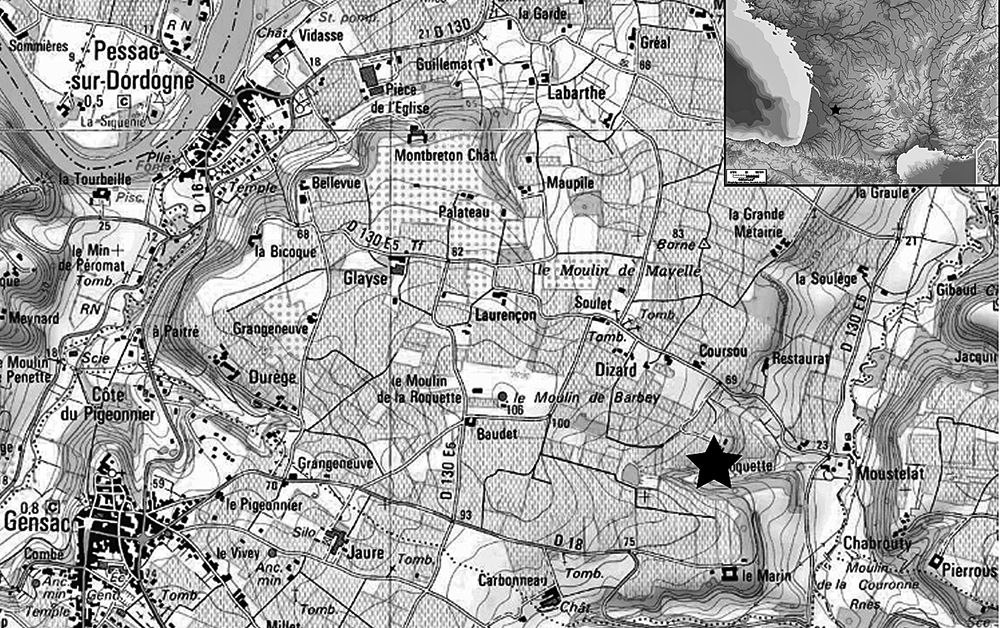
Map of the location of le Morin.
Photo: Maligne et al (2012)
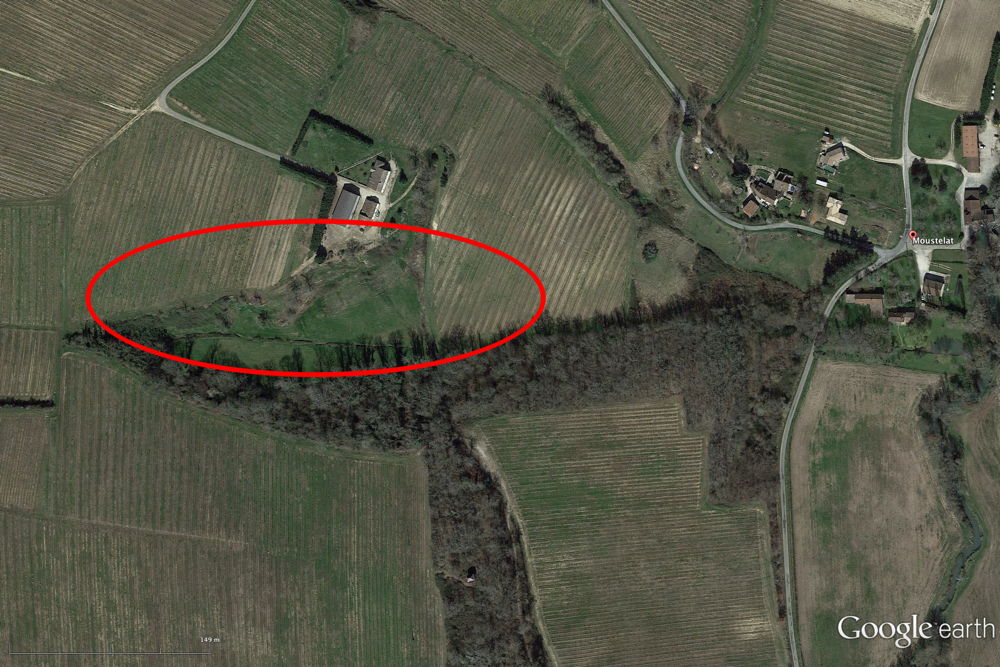
Le Morin as it is today, outlined by the red oval.
Photo: Google Earth
Deffarge et al. (1975)
Translation: Don Hitchcock
L'abri Morin at Pessac-sur-Dordogne (Gironde) contains several levels of the Magdalenian V (BII) and VI (BI, A IV-I). Many works of art have been unearthed there during the excavations of R. Deffarge, who with J. Elzière made the first interpretations, accompanied by relevant photos and drawings. D. de Sonneville-Bordes and P. Lawrence have recorded further descriptions, using the drawings by P. Lawrence. Determinations of the substrates (e.g. bone, sandstone and so on) and the species depicted were carried out by F. Prat and F. Delpech. The descriptions are based on published works of anatomy and palaeontology.
Descriptive Analysis
74 objects of bone or antler, as well as one of sandstone, were selected for study. These were organised into identifiable animals, plants, human body parts, barbed arrows and, exceptionally, a very elaborate design, as well as antlers carved in a phallic shape. To this is added two engraved bones lacking a known stratigraphic origin. These objects come from all levels of the site: B I, 2; A IV, 18; A III, 23.
There are, in addition, bones with engraved lines where it is not possible to recognise shapes: BI, 2; A IV, 18; A III, 23. With regard to the illustrations, they have been oriented to make interpretation of the carvings easier. Where it exists, the spongy part of the bone is considered the underside.
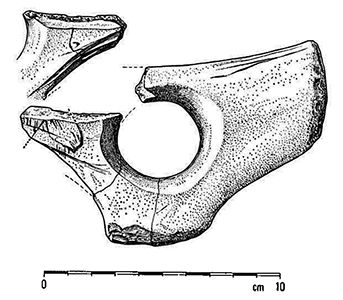
Abri Morin Layer B II, Fig. 1, No. 1. - Distal part of a spear straightener of reindeer antler, 3 fragments.
Length 134 mm, width 73 mm.
Engravings on both sides of the piece. The piece was cut into two pieces after manufacture, in order to use it as a hammer to create flakes of flint, which resulted in the break at the edge of the hole and the partial destruction of the earlier engravings. It was used as raw material without taking account of its previous function or the engravings, probably because it was already broken.
On one side, the remaining lower part of a horse's head, and the beginning of the neck. The muzzle is square, nostrils and mouth are indicated, and the bulge of the lower jaw; some shading in the neck and under the lower lip, perhaps the beard. On the opposite side, a curved line may be testimony of a similar symmetrical figure.
Photo and text: Deffarge et al. (1975)

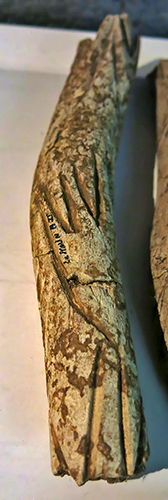

Abri Morin, carving on reindeer antler.
Photo (left): Deffarge et al. (1975)
Photo (centre and right): Don Hitchcock 2015
Source: Original, Musée d'Aquitaine à Bordeaux
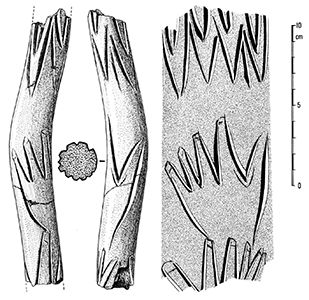
Abri Morin Layer B11, Fig. 2 and 3, No. 2
Length 166 mm, width 25 mm.
Part of reindeer antler in two fragments. On the right, the complete design rolled out.
On almost the entire perimeter of the antler there are deeply incised lines, divided into two groups arbitrarily designated herein as the lower and upper series.
Photo and text: Deffarge et al. (1975)
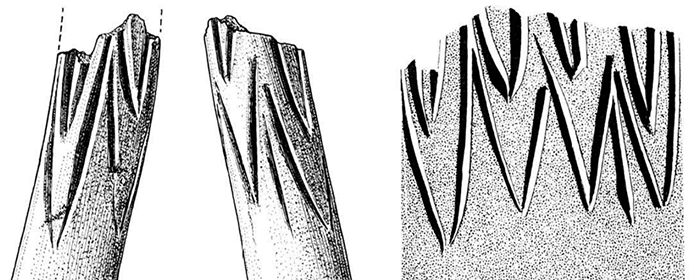
Upper Series:
The design is interrupted by the breakage of the antler. There are two sets of four chevron acute angles, in nested pairs.
Their arrangement is reminiscent of a series of nested chevrons engraved on deer antlers, from Bruniquel, interpreted as a stylised triangular tail fin by H. Breuil and R. Saint-Perier.
For A. Marshack, they are a representation of rain or water.
The series is very fragmentary, and has no apparent meaning.
Photo and text: Deffarge et al. (1975)
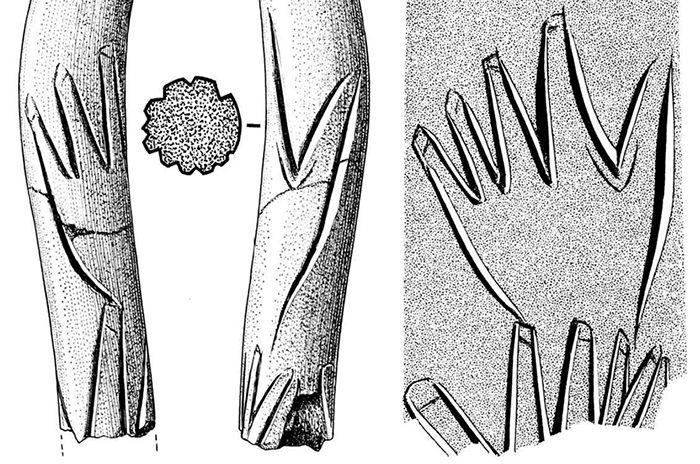
Lower Series:
Two line groups are arranged one below the other. The top is the top side of a left hand with fingers apart, the thumb a little bit more than the other fingers. The base of the fingernail is indicated by a light slash, except on the thumb.
Anatomical proportions are not respected:
• the palm is wider than normal, as are the bases of the fingers;
• the index is the longest finger;
• The finger length decreases regularly from the index to the little finger;
• The thumb, probably shown in profile, is tapered and relatively lengthened. As at Castillo, the hand is broad and the fingers are short.
Two slightly engraved lines that duplicate the line between thumb and forefinger show perhaps the fold of skin at this juncture.
Photo and text: Deffarge et al. (1975)
At the 'wrist' of the previous figure, a group of lines interrupted by breakage seems to be the end of the five fingers of a right hand, as seen from its upper face, all showing the base of the fingernail. The flat, long, and spatula shaped thumb is shown as not connected to the other fingers.
The little finger overlaps the ring finger. On the right, a light line, interrupted by breakage, cannot be interpreted.


It should be noted that hand figurations in portable art are much rarer than in wall art, and thus are very questionable when identified as such.
The hands of l'abri Morin are thus very exceptional, both in their technical realisation, by very deep incisions, and their arrangement and dimensions. This is a pair, one right and one left hand, one below the other, with five fingers, the thumb separated and lines indicating fingernails.
Compared with the hands known from parietal contexts, they differ in proportions from the elongated hands with fingers close together of la Madeleine, and differ from the hands of Laussel, Isturitz and Laugerie Basse, all of which have only four fingers except for the 'Femme au Renne'.
A unique example in portable art, the hands of le Morin will probably not have the same meaning as the parietal hands, which have been interpreted as magic signs taking possession of game, or the land, or as female sexual symbols. The hand is often interpreted as the symbol of invocation and supplication. However there is no reason to try to give a precise meaning to those from le Morin.
Text: Deffarge et al. (1975)
Photo: Don Hitchcock 2015
Source: Original, Musée d'Aquitaine à Bordeaux
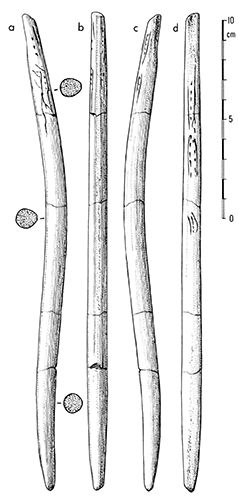
Fish (?)
Complete sagaie (spear point) artefact type, double curvature, of reindeer antler, in five pieces.
Length 240 mm, width 11 mm. Subcircular section, one end worn or eroded, the other of spongy or trabecular bone. Light engravings at one end, distributed over the three faces a, c, d to the exclusion of face b, which is slightly flattened, but without decoration. The patterns consist of two longitudinal parallel lines between which are aligned single or double sets of marks and further isolated features (a).
Their general shape recalls the pisciform figurations H. Breuil and R. Saint-Perier, the major difference being that their surface is not decorated with transverse parallel lines, but the marks are aligned to the object. The traditional interpretation of diagrammed fish is highly questionable.
Photo and text: Deffarge et al. (1975)


Barbed designs. - mesial fragment of reindeer antler spear.
Length 58 mm, width 7 mm. Section quadrangular. Light engraving on one side. A triangular motif showing an angled or slotted base, with six irregularly distributed marks evokes a tail comparable to a fish, construed as representation of forked caudal fins, seen in vertical projection.
Above this motif, a schematic harpoon with a pointed base with five barbed lines on the right side of the rod and a light line engraved on the left side.
The relationship between the two patterns is perhaps that of the weapon and game, in the classic hypothesis of a magical significance of art: the tail symbolises the fish, the portion contains the evocation of the whole.
Photo (left) and text: Deffarge et al. (1975)
Photo (right): Don Hitchcock 2015
Catalog: 88.47.4
Source: Original, Musée d'Aquitaine à Bordeaux
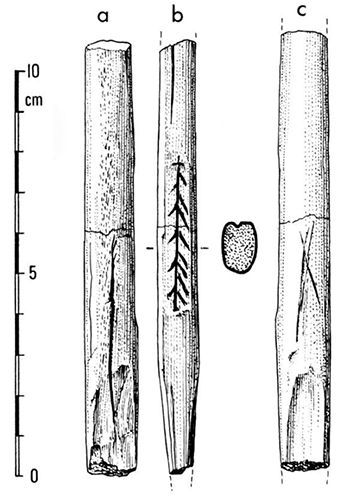

Proximal fragment of a reindeer antler spear head.
Length 107 mm, width 14 mm. Section subquadrangular, with a double beveled broken base.
On the underside is a deep incision on the axial shaft and bevel. On the upper face, c, two light lines intersecting. On the flank b, on a flat section carved from the round a deep etching of a longitudinal rod, with five spread out oblique lines on the left and eight oblique lines closer together on the right; at the top, a longitudinal incision. This figure can be interpreted as a barbed arrow or as bilateral barbs on a spear.
(note that the diagram shows a fragment of a spear head, while the photo is of an essentially complete spearhead, albeit with a break at the previous limit of the object. It would seem that the rest of the spear head was located since the 1975 paper was published - Don )
Photo (left) and text: Deffarge et al. (1975)
Photo (right): Don Hitchcock 2015
Source: Original (?), Musée d'Aquitaine à Bordeaux
The diagrams (and photographs of the originals above) shown here, interpreted as harpoons with one row of barbs, and harpoons with two rows of barbs coexist in level B II on a work in progress and harpoon fragments with either one or two rows of barbs, the single row of barbs establishing the allocation of that artefact to the Magdalenian V.
The dual coexistence with respect to the Magdalenian V and VI cast a shadow on the traditional position, and explains the apparent anomaly of a harpoon with a single row of barbs in the layers of the Grande Salle d'Isturitz, which had otherwise exclusively harpoons which were bilaterally barbed.

We have identified three types, as shown at left.
a: short type
b: long type with barbs close together
c: long type with barbs well spaced, and with the barbs on the shaft sometimes doubled up, as with the barbs on the right.
The problem of the significance of these differences has long been debated.
Photo and text: Deffarge et al. (1975)
Attributed to the Magdalenian V or perhaps to the start of VI, level B II is poor in works of art. It is distinguished by an exceptional representation of hands and the presence of two barbed signs on the site, while the horse's head and schematic fish (?) are banal and mediocre.
Except for a reindeer antler, the designs are carved on tools, spears and a bâton à trou (spear straightener ).
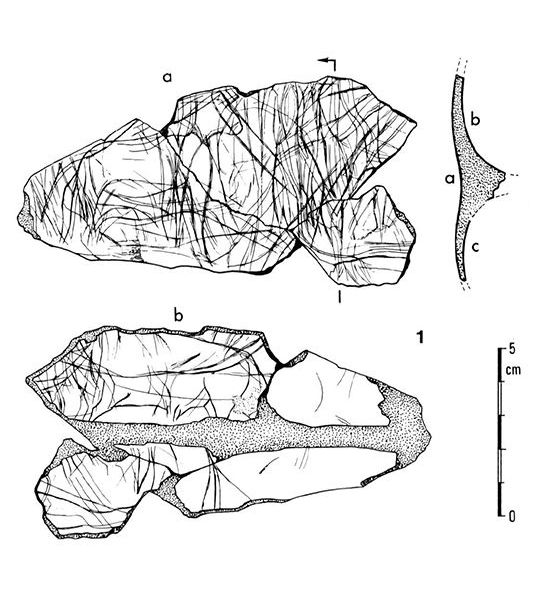
Horse from layer B I Exterior
Scapula fragment in three pieces. (note that a is one side of the scapula, b and c are on the other - Don )
Length 128 mm, width 64 mm.
The back of the scapula (also called the dorsal or posterior surface) is arched from above downward, and is subdivided into two unequal parts by the spine of the scapula. The portion above the spine is called the supraspinous fossa, and that below it the infraspinous fossa - Wikipedia )
There are light engravings on the upper face a and on the lower face in this case both on the upper (b) and lower (c) sections, that is, the supraspinous and the infraspinous fossae.
a) on the left, a complete horse, standing still, in right profile. The short head has a short, round muzzle. The neck is large and arched, the back straight, and the rump drooping. The tail is shown as being thick, long, and floating. Barely legible amongst the secondary lines, a pair of legs are incomplete. The line of the belly is just distinguishable. On the right, the overlapping, mostly vertical strokes have no apparent meaning.
On the other side: b) Bovid in left profile, walking, a fracture has removed the head, a portion of the line of the back, and the lower legs. The front of the chest is indistinguishable among the secondary lines. The rest of the body is easily recognisable: the bent foreleg, the belly line with perhaps the penis, the hindquarters with well designed thigh, and a thin tail attached high, and raised.
Photo and text: Deffarge et al. (1975)
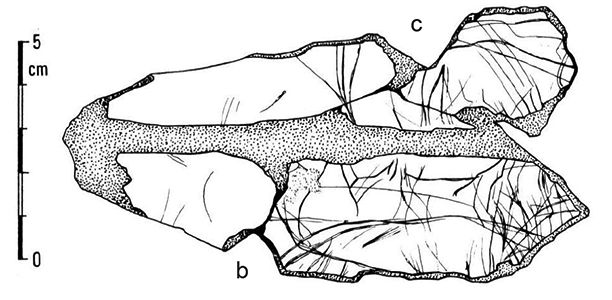
At c), on the same face, when the bone is rotated as shown, we can see the hindquarters of a horse with a thick, drooping tail. The secondary lines are less numerous on the lower face than on the upper face.
Photo and text: Deffarge et al. (1975)
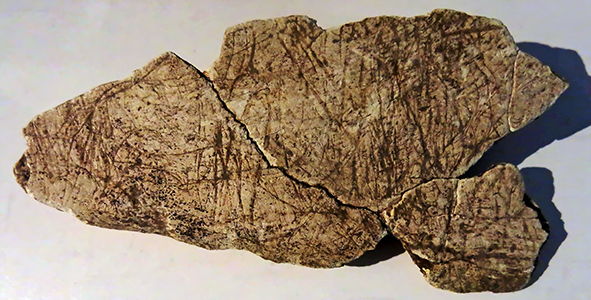
Engraving of a horse and other lines, as above, from Le Morin, Pessac-sur-Dordogne
Material: Bovid left scapula, interior side
Age: Upper Magdalenian, Magdalenian VI
Photo: Don Hitchcock 2015
Source and text: Original, display at Musée d'Aquitaine à Bordeaux
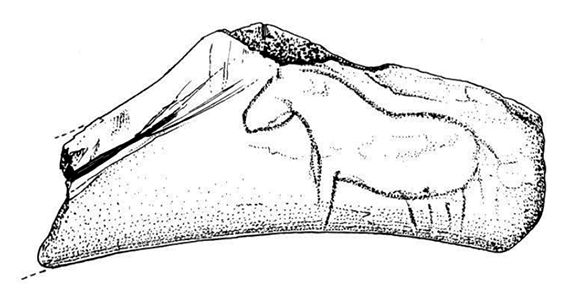
A standing horse in left profile. It is complete except for the unfinished legs, and is without details. The deterioration of the piece has resulted in the erasure of some of the outline.
The head is short and deep, with a flat forehead, rounded snout, the lower jaw indicated by a slight swelling. The neck is short and thick; the back is swayed slightly, the hindquarters are rounded, with the tail high on the rump, swollen and hanging. The left foreleg is narrower than the hind legs, which are placed in an anatomically false position. The general outline is awkward.
Material: Reindeer antler fragment. Length 105 mm, width 46 mm.
Photo and text: Deffarge et al. (1975)
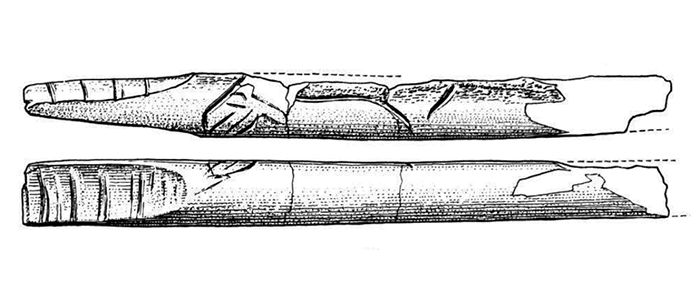
Part of a spear point made from reindeer antler, in three fragments.
Length 142 mm, width 13 mm. Base is a double bevel, squarely cut, with wide slightly curved transverse incisions, made by several lines. The shaft is of subcircular section. On the left edge, a deeply incised engraving of an incomplete schematic horse, in left profile, standing. The lower part is missing.
The head is long and overly voluminous, with a flat forehead and square muzzle. The eye is very large, and the line of mouth and cheek is indicated. The mane is thick, the back straight. The tail is shown as an extension of the croup, and is short and raised. Behind the animal, two lines, perhaps the beginnings of a head.
Photo and text: Deffarge et al. (1975)
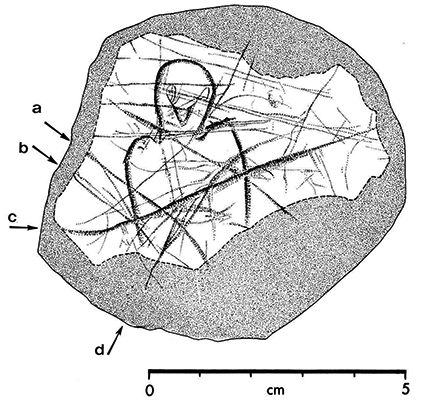
Bird or anthropomorphic figure
Fragment of pink subcircular sandstone. Height 64 mm, width 75 mm. The edge is partially shaped, with later breaks in the engraved lines. It may have served as a 'hammer-grinder'. On one side, there is an irregular surface with some engraved lines, and on the other, the surface is flat, and bears an etching whose sharpness has been attenuated by the texture of the rock.
The figure is a front view: the head is rounded, it has asymmetrical shoulders, square, raised and extended, with a broad chest. On the front, two lines in a V represent a nose or a beak and two oval tracks, barely legible, denote eyes.
There is no neck, only a small narrowing of the head, so the figure is a 'head placed on shoulders.' Some lines, outside the figure, extend beyond it but intersect at the location of the neck and chest, where they are clearly marked. The significance of their relationship with the figure is not obvious.
The hypothesis of an anthropomorphic figure is plausible, but studies devoted to human representations on parietal locations show that they are rarely shown from the front. In these cases, they have rounded heads and round or oval eyes, and when the torso is shown, they are depicted without shoulders.
Photo and text: Deffarge et al. (1975)
Because of its beaked nose, this figure from Morin belongs to the group of hybrid bird or masked figures. The hypothesis of a bird identity is perhaps more likely, because of the large size of the head and the raised shoulders, which suggest the folded wings of a bird of prey, probably a snowy owl, well represented in the bones of bird life discovered at the site. The shape of the head, the eye, and especially the 'chevron reversed' beak closely matches the snowy owl from les Trois-Frères.
Photo and text: Deffarge et al. (1975)
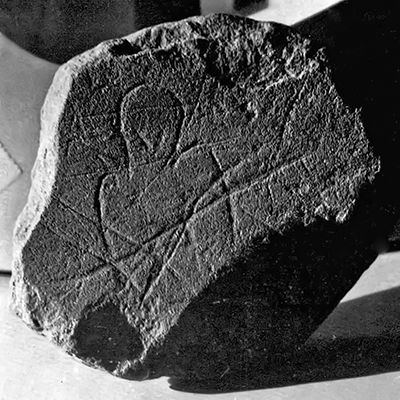
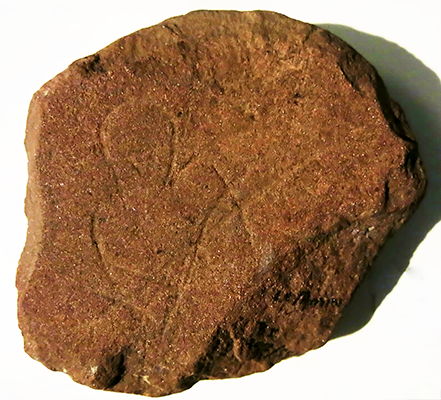
Engraving of an owl from Le Morin, Pessac-sur-Dordogne
Photo (left): Deffarge et al. (1975)
Photo (right): Don Hitchcock 2015
Source: Original, Musée d'Aquitaine à Bordeaux

The snowy owl (Bubo scandiacus ) is a large, white owl of the typical owl family. They are native to Arctic regions in North America and Eurasia. Younger snowy owls start with darker plumage, which turns lighter as they get older. Males are almost all white, while females have more flecks of gray plumage.
Photo: © Dr. Peter Schmidt
Permission: Creative Commons Attribution 2.0 Generic license.
Text: Wikipedia

Line of horses - proximal part of a spear head made of reindeer antler, in four fragments. Length 137 mm, width 10 mm. The shaft is subquadrangular in section, with oblique lines on the upper side.
The end of the base is slightly rounded, with two slightly concave bevels, striated with fine oblique lines. (this feature is common on spear point bevels, presumably to make the attachment to the rest of the spear more secure - Don )
Photo and text: Deffarge et al. (1975)
 Photographs of the carving (left side) of the line of horses.
Photographs of the carving (left side) of the line of horses.
Photo: Don Hitchcock 2015
Source: Original, display at Musée d'Aquitaine à Bordeaux
Each side is engraved in Champlevé style (i.e. the exterior of the outline is hollowed out by a channel, as if to take glass enamel. This gives a three dimensional effect - Don ) with a line of four horses, in left profile on the left side and in right profile on the right side. Part of a fifth horse remains, before the lead horse, as a tail on the left side, and a tail and rump on the right side.
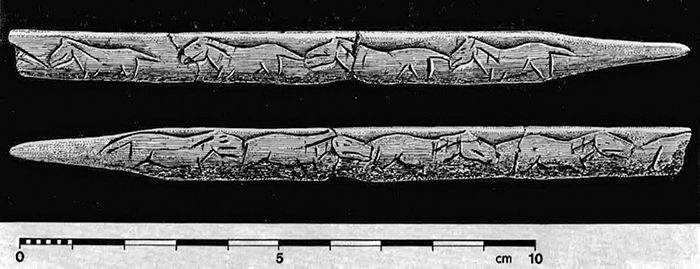
Left side: Length of horses, first to fourth: 22 mm, 25 mm, 30 mm, 25 mm.
The lead horse is clearly separated from the tail of the fragmentary horse which precedes it and also from the head of the horse which follows it. Conversely, the nose of the third horse touches the tail of the second and its tail is lightly touched by the nose of the fourth horse.
All horses are represented by similar methods - a continuous line draws the outline, from the forelock to the tail, with a slightly swayed back and a compact, tapered tail. The elongated head has a flat forehead and rounded snout; an exaggeratedly extended line marks the mouth, which, for the 3rd horse, is misplaced under the eye; the eye is indicated by a single line for the first horse and by two for the others.
Photo and text: Deffarge et al. (1975)
The jawbone is protruding. On the neck an oblique line marks the limit of the mane. The legs, one per pair, are incomplete. They are shown as if the animal is running, the front leg stretched forward, the rear leg stretched back. The belly is slightly swollen, the thighs enlarged. On the third and fourth horse an oblique line separates the belly from the flanks.
Right side: Length of horses, first to fourth; 27 mm, 25 mm, 26 mm, 28 mm.
Except for the last horse, whose tail is stretched out and is fully visible, and is illustrated by two lines, the tails are partially hidden by the heads and delineated by just one stroke.
This line of animals is less realistic than the other. The muzzles are more angular, the jawbone less well marked, the line of the mouth is misplaced. Some features, perhaps tufts of hair, overlap the line of the mane.
The degradation in the quality of execution of the engravings between one line of horses and the rest may indicate that this line of horses was completed at a later date than the first, evidence of fatigue of an artist working on a similar series of figures, or the poor quality of the series may indicate the awkwardness of a copyist, who was not the original artist.
The motif of lines of animals, especially horses, on spears and spear straighteners, is well known in the Magdalenian VI, and especially in the Perigord. According to H. Breuil and R. Lantier it is not found in the Pyrenees.
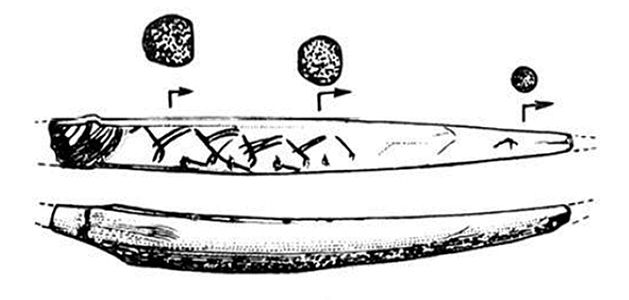
Almost complete distal fragment of a spear point made of reindeer antler.
Length 84 mm, width 9 mm. The point is worn. The base is broken off, the shoulders of the base consist of two slightly concave bevels, incised with oblique lines.
Photo and text: Deffarge et al. (1975)

The rounded shaft has been flattened on one surface, and has been engraved with a line of five horse heads. The heads are in right profile. Each overlaps the next, and the heads decrease in size slightly from left to right, which gives a sense of perspective.
Photo: Don Hitchcock 2015
Source: Original, Musée d'Aquitaine à Bordeaux

At both ends, the heads are unfinished, the left with only the muzzle and nose, while that of the right has the muzzle including the forehead, the nose and the mane. The heads of the horses in the middle, numbers 2, 3, and 4, are complete, with the beginning of the neck. There are no eyes, (? Number 3 appears to have an eye, and possibly number 4 as well - Don ) no ears, just two parallel lines for the mane, and a line for the nostril.
Photo: Don Hitchcock 2015
Source: Original, Musée d'Aquitaine à Bordeaux
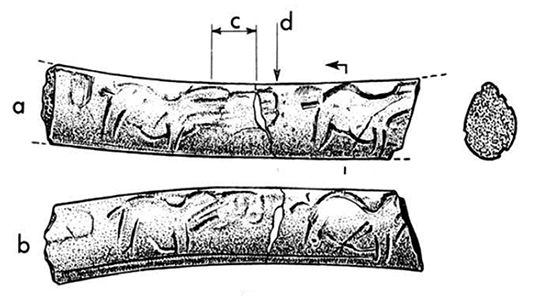
Mesial (middle ) fragment of reindeer antler in two pieces. Length 86 mm, width 16 mm. The two sides are engraved similarly by two horses standing in right profile. The head of the horse on the right has been broken off. The horse on the left is difficult to read correctly, because of the deterioration of the antler on which it is carved. Between the neckline and the break at c, some lines which are difficult to interpret represent either a normal sized head, part of which has been erased, or a disproportionate head whose nose would be located beyond the break on the right hand fragment, at d, if the lines were clearly legible.
The profiles are characterised by saddleback (the back dips in the middle), well marked and placed well forward, the large and rounded rump, by the very short and taut (straight) tail, the swollen belly placed well towards the front. One unfinished leg represents each pair of legs. By their plump proportions, these horses recall others on the site. At the base of these engravings, a longitudinal groove is clearly visible on face b, and there is a barely perceptible similar line on face a.
Photo and text: Deffarge et al. (1975)
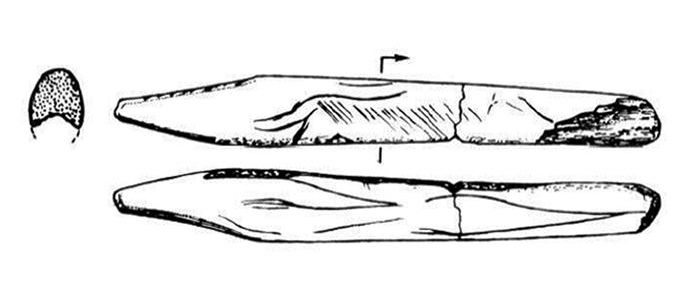
Proximal fragment of a sagaie, a spear head in reindeer antler, in two pieces. Length 105 mm, width 14 mm. The rectilinear base has been blunted by use, with two bevels engraved with oblique lines (a common feature on such objects - Don ).
The lower spongy face is very deteriorated. The engravings are made on the sides of the spear head. On the right side, there is an incomplete horse in right profile, without forequarters. The back is swayed, the tail raised, the very partial hind leg is thrown back. Oblique hatchings of unequal length cover the body and what corresponds to the forequarters. Like the leg, the line of the belly is interrupted by the edge of the object. On the left side, there are two spindle shaped lines.
Photo and text: Deffarge et al. (1975)

Distal fragment of reindeer antler spear head. Length 63 mm, width 11 mm. Shaft is of quadrangular section, has a double bevel which is weakly convex, with three oblique lines on the upper face of the bevel and on the lower spongy face.
On each side, there is an incomplete and schematic engraving of a horse in right profile on the right side, and in left profile on the left side. More complete than the horse on the left which lacks a head, the horse on the right has a large head from which the nose has broken off. Two oblique lines mark the eye.
Some features suggest a mane and perhaps an ear. The back is slightly swayed. The long, floating tail may indicate movement. The beginning of the front leg has been drawn, but the hind leg is not represented. The line of the belly may have been destroyed by the disintegration of the spongy part of the antler.
Photo and text: Deffarge et al. (1975)

Fig. 10, No. 7 - Fragment of a bâton perçé made of reindeer antler, in four pieces. Length 154 mm, width 19 mm. The piece has a double curvature. A small portion of the hole of the spear straightener remains. Both sides are etched deeply by lines. A flat area was made, on the ridge to the right of the horse engraving.
Near the perforation, an incomplete triangular pattern in champlevé (the outline is surrounded by a deeply carved channel - Don ) is very classic, a common decoration at that location on pierced sticks.
At the other end, a horse shown in right profile is shown galloping. The head is partly destroyed, but the forelock is visible. The back is straight, the tail is floating. The hind leg is stretched back, and the front leg, of uncertain location, with apparently excessive width, is projected forward. The belly is not bulging.
Two thin lines without any apparent relationship to the figure may have been there prior to the engraving of the horse. One is outside the outline of the animal, in front of the neck, and the other passes through the body from neck to tail. Between the horse and the hole of the spear straightener, there are a series of deep oblique wavy lines.
Photo and text: Deffarge et al. (1975)

On the other side of the piece, shown in these photographs, there is a series of nine oblique lines, then a group of three lines, of the same type as the previous ones, as well as several lighter strokes.
Photo: Don Hitchcock 2015
Catalog: 88.47.15
Source: Original, Musée d'Aquitaine à Bordeaux

Mesial (centre) fragment of a bird bone. Length 61 mm. It is clearly engraved with a horse showing the left profile, certainly standing at rest. The front part of the head, the front leg and the end of the hindquarters have been broken off.
While the forequarters, well proportioned, are of a very classical realism, the rest of the horse is very schematic. The ear is shown. Some strokes above the forehead indicate the forelock, and below the jawbone the beard; a double set of shading shows the mane, more spaced out on the head and closer together towards the back.
Irregular shading on the flank and a double series of lines along the line of the back indicate hair. Two lines beginning on the left foreleg have been terminated by breakage. Deep lines trace the contour of the back, very slightly swayed, and the swollen belly: they converge towards the hindquarters. An oblique line is perhaps the outline of a very schematic left hind leg.
Above the animal, a curved path parallel to the line of the withers and a zigzag pattern known from elsewhere remain without apparent meaning.
The combination of a realistic drawing of the forequarters together with a schematic layout for the rear of the horse is found on an equine etching from l'abri Murat (Lot), which is, moreover, far less figurative.
Photo and text: Deffarge et al. (1975)
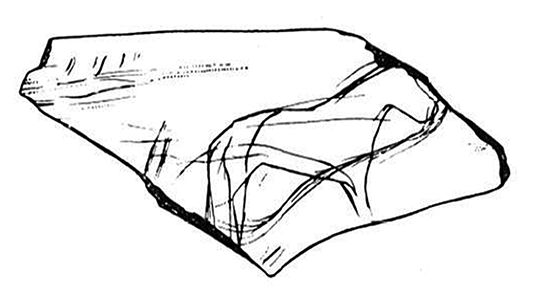
Fragment of a large bone. Length 90 mm, width 43 mm. An engraving of a complete horse in right profile, standing, very finely engraved, but without details. The head is elongated, and the muzzle square. The layout of the rear part of the horse is confused and awkward, with, apparently, a long hanging tail.
The legs are straight, both at the front and rear, and have been drawn without care and diligence. The belly line rises obliquely to the hindquarters. A group of lines, without apparent significance, goes from the muzzle to the rear leg.
Photo and text: Deffarge et al. (1975)
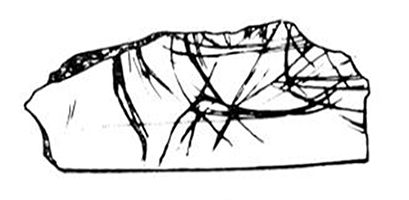
Fragment of a scapula, length 51 mm, width 21 mm.
Finely engraved, incomplete drawing of a horse (?). The line of the belly , the right hind leg and rump are indicated.
Photo and text: Deffarge et al. (1975)

Fragment of a scapula. Length 69 mm, width 21 mm.
Thin lines of varying orientation suggest a drawing of hindquarters, perhaps of a horse.
Photo and text: Deffarge et al. (1975)

Bison. Fragment of reindeer antler cut longitudinally on both sides after the delineation of the engraving, of which the lower part was cut off.
Length 65 mm, width 30 mm. Cut in the champlevé manner, part of a bovid in right profile. The steep slope of the back, the angular rump, the thin and pendant tail and the mane identify this as a bison.
Behind the animal, two fine lines, and two deep lines.
Photo and text: Deffarge et al. (1975)

Right profile forequarters of a reindeer whose posterior has disappeared after a break. Mesial fragment of a bird ulna. Length 78 mm.
The size of the head, neck and neck are of excessive size, and are disproportionate to the rest of the body. Many anatomical details are accurately represented: the part of the antler shown with an enlarged 'palm patch' (the end of the antler which may look like a hand with fingers - Don ) and the 'ice antler' (I have been unable to find a definition for this, but the most likely (based on the engraving) seems to be the smaller forward facing antlers low down near the head. I would be grateful for confirmation from a French speaking reindeer expert! - Don ).
Other accurate representations include the eye with a visible tear duct, the erect ears, thick muzzle with the line of the nose and the mouth, the contour of the cheek, the prominent withers, the attachment of the right foreleg, the spindly legs, all four represented but unfinished, fine shading and closeness of the coat on the back and neck and shoulder, as well as the dewlap.
The illusion of a walking motion is expressed by the head and neck extended forward, and the position of the left foreleg. (or, more likely, the attitude of the 'low stretch display' - see below - Don ) In its proportions, the attitude, and some detail, including the tear duct and hair on the dewlap, this engraving closely matches one from Laugerie Basse in the Musée de Périgueux (as shown in the photograph below ).
Photo and text: Deffarge et al. (1975)
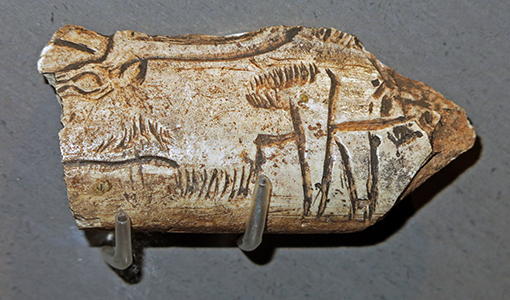
Reindeer head and forequarters engraved on bone from Laugerie Basse, to be compared with the engraving above from l'Abri Morin.
The reindeer bull is in what is called a 'low stretch display', used between a calf and a cow, by a bull approaching a cow in the rutting season, and as a threat display from one bull to another subordinate adult bull. Note that the engraving above from l'Abri Morin also appears to be of a bull in a 'low stretch display'.
My thanks to Andrea Castelli for his insights on this pendant.
Label: Os gravée, Laugerie-Basse, Fouilles Hardy, Périgueux, Musée d’art et d’archéologie du Périgord, Pr.A. 1901
Photo: Don Hitchcock 2015
Source: Original, Musée d'Aquitaine à Bordeaux
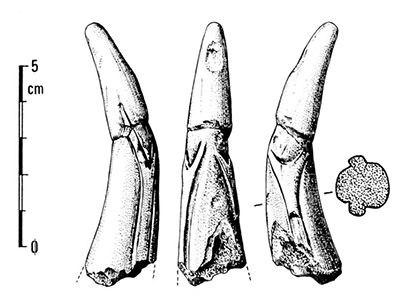
Cervid. End of reindeer antler, in two pieces. Length 73 mm. It is perhaps phalliform.
On the two opposite faces, two figurations in champlevé (the outline is surrounded by a deeply cut channel ) of the end of a deer antler, with the rod and a 'palm patch' (just below where the antler divides, as in fingers on the end of a hand - Don ).
Photo and text: Deffarge et al. (1975)
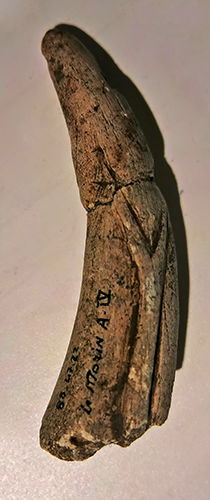
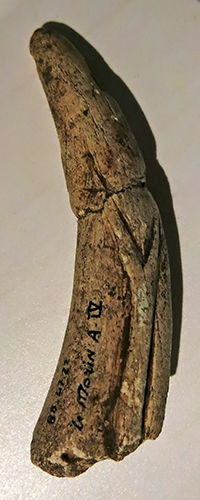
On one face (shown here), the two points are of unequal size, the longest, called the dagger, thus being differentiated. On the other, the points are of equal length. A deer antler from Gourdan, sharpened, is decorated like this with two deer antlers in champlevé style.
Text: Deffarge et al. (1975)
Photo: Don Hitchcock 2015
Source: Original, Musée d'Aquitaine à Bordeaux

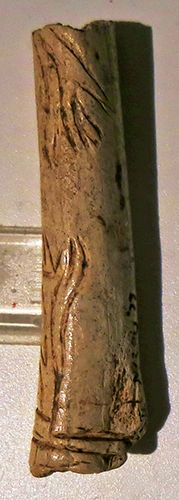
Mesial fragment of the radius of a bird, sawn off at one end. Length 51 mm. Two deer antler carvings lie opposite each other. One is located towards the sawn end, and is limited by two horizontal lines, while the other is interrupted by breakage of the bone.
Both are depicted in real perspective, with the antler in the foreground superimposed on the other, which is thus partly hidden. Only the palm patches of the antlers remain for the branches at the top. If the lower antler is complete, it is an antler of the second head (3rd year).
In the carving at top, the rod of the antler in the foreground, includes the 'palm patch' and the points, while in the background, partly obscured, the drawing shows the rod and the palm patch of the other antler.
Several explanations for these branches of figurations can be advanced. It could be the classical tendency to use the part to represent the whole, the antlers in this case in lieu of the full deer. More likely, the branches are represented for themselves because of the attraction they exert, perhaps as scrap antler for tools, or as hunting trophies.
Nevertheless, there is a magical feeling to the work, such as is evidenced by the sorcerer of the Three Brothers, the precursor to Indian or Siberian shamans.
Photo (left) and text: Deffarge et al. (1975)
Photo (right): Don Hitchcock 2015
Source: Original, Musée d'Aquitaine à Bordeaux
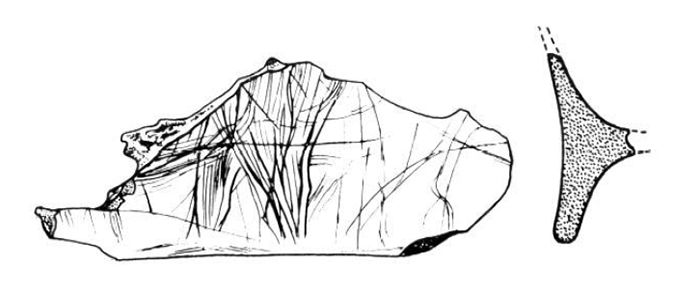
Fragment of a scapula, length 80 mm, width 31 mm, showing a jumble of lightly traced lines, in which may be seen, in deeper engravings, two incomplete hind legs and part of the line of the belly of an animal, perhaps a deer in left profile.
This figure has a large number of lines, mostly oriented parallel to the direction of the legs.
Photo and text: Deffarge et al. (1975)
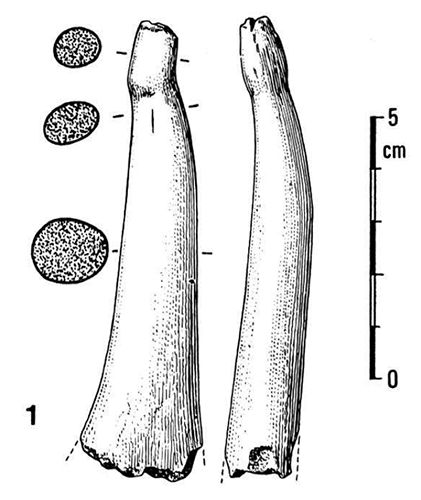

End of reindeer antler. Length 88 mm. The distal portion has been scraped to the shape of a phallus, with normal peripheral narrowing and an incision of the penis at the glans shown, which has since deteriorated to some extent.
The shaping of the phallus was relatively easy because of the natural shape of the antler. The object is similar to other carved antlers, in the sense that it is simple and undecorated, as for, notably, number 7 of layer A II from the same site, and the phallus from la Madeleine, or the very ornamented one from Bruniquel and that from Abzac, which is a double version.
When discussing a wooden phallus from the Aurignacian, coming from l'abri Blanchard des Roches, much earlier than the examples cited above, which are all from the upper Magdalenian, L. Didon proposed the existence of a very ancient cult of the male genital organ.
R. Montandon thought that the objects were intended to 'satisfy perverted desires' (that is, that they were dildos - Don ).
Photo (left) and text: Deffarge et al. (1975)
Photo (right): Don Hitchcock 2015
Source: Original, Musée d'Aquitaine à Bordeaux
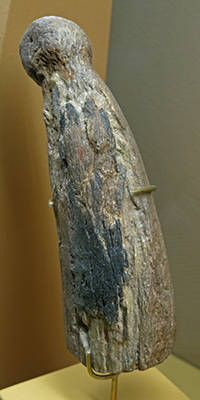
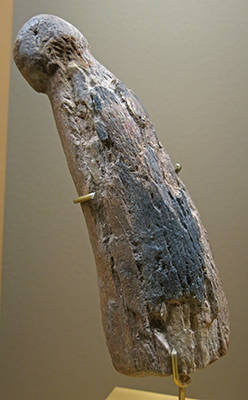
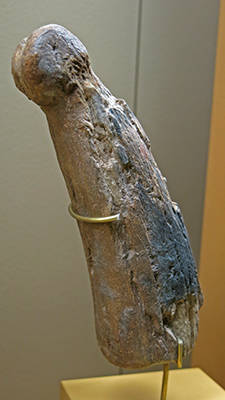
Aurignacian of l'abri Blanchard des Roches à Sergeac, Dordogne
Sculpture figurant un phallus, corne, sculpture of a phallus, horn.
Photo: Don Hitchcock 2014
Source: Original, Musée d'Archeologie Nationale et Domaine, St-Germain-en-Laye
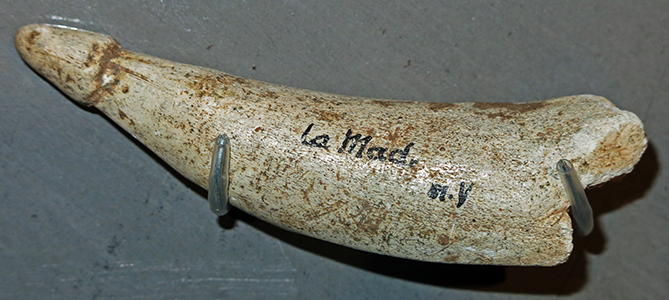
Phallus from la Madeleine.
Carved in the round from reindeer antler, on loan from Les Eyzies-de-Tayac, musée national de Préhistoire.
Label:
Bois de renne sculpté en ronde bosse, La Madeleine, Fouilles Capitan et Peyrony
Les Eyzies-de-Tayac, musée national de Préhistoire, MNP 1928-7-15
Photo: Don Hitchcock 2014
Source: Musée d’art et d’archéologie du Périgord, Périgueux
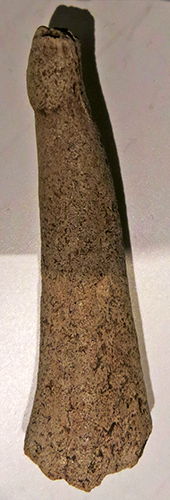
To link these phalluses to magic or to a fertility cult, it must be assumed that the relationship between the sexual act and conception was understood by people of the Upper Paleolithic.
Regardless of their meaning and their use, these very realistic phalluses show that a psychological restriction against showing sex organs was not absolute.
They may be further evidence of the innate tendency of humans to transform, by simple work, a suggestive natural form.
Text: Deffarge et al. (1975)
Photo: Don Hitchcock 2015
Source: Original, Musée d'Aquitaine à Bordeaux
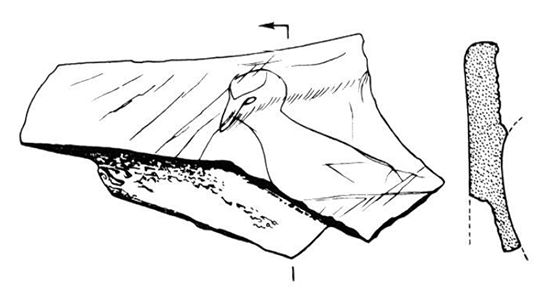
Fragment of a scapula. Length 93 mm, width 45 mm. Lightly engraved figure of a bird in left profile. The head is rounded, with almond-shaped eyes, a short beak, robust and sharp, a cap on top of the skull, which evokes perhaps a spot of colour. The neck is well marked, and the figure has a bulging chest, with the line of the back sloping.
Shown without legs, the bird appears to be sitting. A line may mark the top of the ground. The species is not identifiable. Spaced oblique lines and a line of short and tight shading have no apparent relation to this figure.
Photo and text: Deffarge et al. (1975)
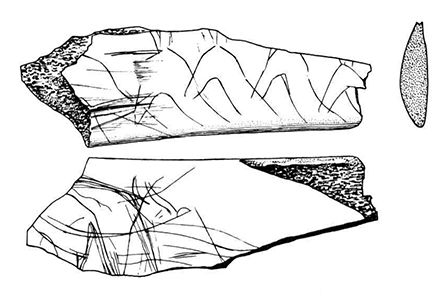
Fragment of a large rib. Length 116 mm, width 37 mm. On one side, light strokes may represent the hindquarters with a drooping tail, and two horns, of an aurochs.
On the other side, very small engravings of five bird heads shown in left profile, are very schematic. The tops of the heads of the birds have been damaged by a break, the rest is complete.
This is a line of birds in perspective, each bird's head overlapping the neck of the preceding one.
These simple silhouettes may be assigned as ducks or swans, because of the very long neck and large beak. Swans are lacking in the avifauna found at l'abri Morin, but the duck, though very rare, is present in all layers. This identification confirms previous observations on the consistency and frequency of waterfowl in the inventories of the few representations of birds in Quaternary art. Those from portable art all belong to the Upper Magdalenian, including the curious wader from Belvis.
(see photo and text below - Don )
Photo and text: Deffarge et al. (1975)
If we include the possible snowy owl above, from Layer B I, the birds of level A IV substantially augment this short list. This is the only known example of a line of birds. It evokes the idea of a flock of birds.
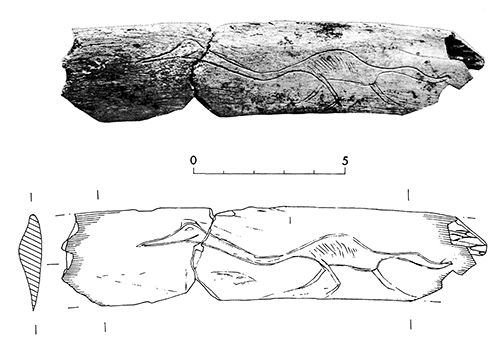
This engraving of a wading bird was uncovered in July 1969 by M. Jean-Pierre Clement in la grotte de Belvis (Aude).
It lay at a depth of 30 cm, near an area long dug up by illegal diggers.
Photo and text adapted from: Saachi (1972)
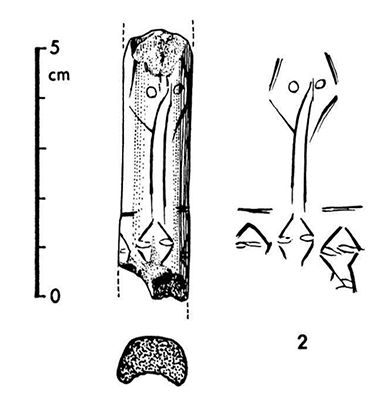
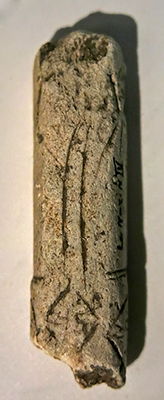
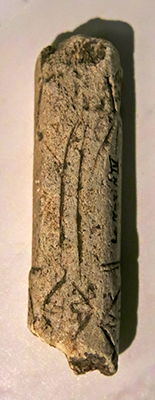
Snake - Middle fragment of reindeer antler spear head (sagaie), length 54 mm.
Two horizontal lines engraved on each side delimit a slight narrowing of the piece. At one end, a rhombic shaped figure, partially degraded by a break, occupies the upper face and extends slightly onto the sides: in the centre, two small barely legible circles, symmetrical with respect to the axis of the piece. Two parallel longitudinal lines converge between the circles. They join this figure to the engravings below.
At the other end are three diamond-shaped figures, each with two symmetrical oval designs, similar to the previous but smaller, transversely aligned, the central figure on the upper face of the spear, the other two on the edges. The most complete, the one on the right, is extended by two slightly divergent lines.
Photo (left) and text: Deffarge et al. (1975)
Photo (centre and right): Don Hitchcock 2015
Source: Original, Musée d'Aquitaine à Bordeaux
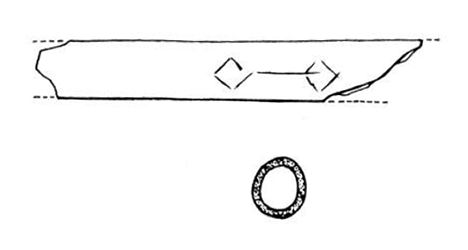
A mesial (middle) fragment of the ulna of a snowy owl. Length 67 mm. There is a very light engraving of two undecorated diamond shapes, joined by a line: one finds this pattern also at Laugerie Basse, where it is interpreted as a very abstract representation of a fish. It could also represent snake heads.
Photo and text: Deffarge et al. (1975)
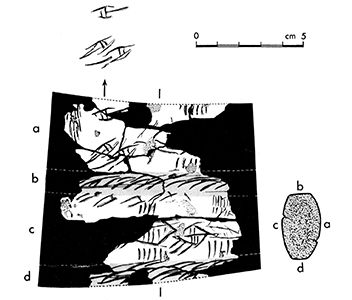
Fish (?)
Reindeer antler fragment in eight pieces. Length 93 mm, width 30 mm. Of sub-quadrangular section, with two lateral flat areas marked b and d, which carry oblique lines, slightly curved.
On sides a and c, deeper lines are organised into spindle shaped and diamond shaped patterns, crossed by transversal lines which could be, in the traditional interpretation, schematic figures of fish.
Photo and text: Deffarge et al. (1975)
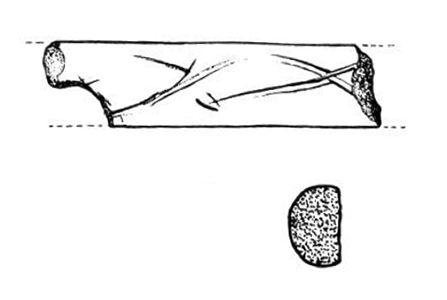
Fragment from the middle of a reindeer antler spear head (sagaie). Length 54 mm, width 13 mm.
On the upper surface intersecting curved lines which may be interpreted as very schematic fish symbols.
Photo and text: Deffarge et al. (1975)

Fragment of the middle of an antler, in two pieces. Length 137 mm, width 25 mm.
On almost the entire surface, there are oblique parallel lines, more or less fine, and more or less spaced out. In the middle, two diamond shapes joined at their points in the manner of pisciform motifs. Groups of deep longitudinal lines, with a very deep trough at one end, at the point marked 'a'.
Photo and text: Deffarge et al. (1975)
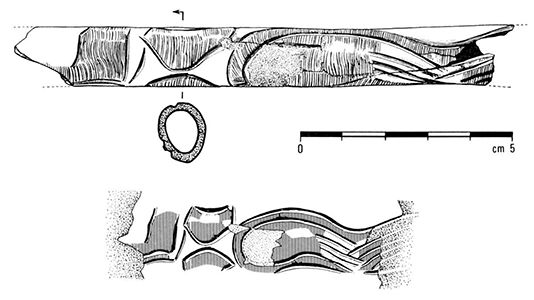
Middle fragment of a bone from a very large bird in 3 pieces. Length 117 mm, width 14 mm.
Very deep engravings delimit patterns with little obvious meaning.
On the left some motifs with a surface shaded by fine closely packed parallel lines.
The drawing shows the bone, and below it the 'rolled out' engraving.
Photo and text: Deffarge et al. (1975)

On the right, a complex oval pattern: a double line outlines a shaded area that envelops the whole decoration; a series of broken lines cover an area that extends to the right by four 'fingers' which are smooth, elongated, tapered, reminiscent of the 'hands' of la Madeleine, interpreted as a five-rayed fluke by Breuil and Sàint-Périer.
Photo and text: Deffarge et al. (1975)

Three 'fingers' partially superimposed perhaps belonged to a symmetric pattern, since destroyed by breakage.
Text: Deffarge et al. (1975)
Photo: Don Hitchcock 2015
Source: Original, Musée d'Aquitaine à Bordeaux

This undocumented piece from le Morin reminds me irresistibly of the form of sticks of barley sugar sold when I was a child. The carving demonstrates total mastery of the medium.
Photo: Don Hitchcock 2015
Source: Original, display at Musée d'Aquitaine à Bordeaux
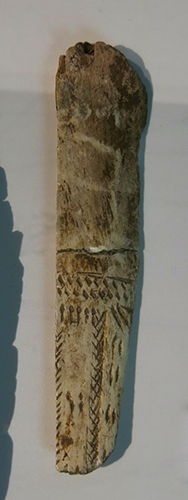
This undocumented piece from le Morin shows geometric designs engraved on its lower half.
Photo: Don Hitchcock 2015
Source: Original, display at Musée d'Aquitaine à Bordeaux
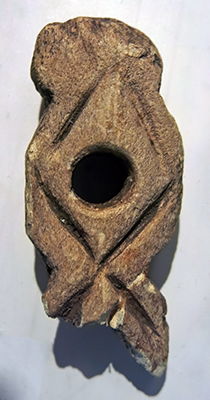
This piece from le Morin shows geometric designs engraved very deeply around a hole.
It is described in the catalog as a harpoon with two rows of barbs.
Length 119 mm, width 25 mm, thickness 8 mm.
Material: reindeer antler
Age: Magdalenian VI
Catalog: 88.47.1125
Photo: Don Hitchcock 2015
Source and text: Original, display at Musée d'Aquitaine à Bordeaux

This beautifully made harpoon from le Morin shows circular designs between the double row of barbs.
Photo: Don Hitchcock 2015
Source: Original, display at Musée d'Aquitaine à Bordeaux
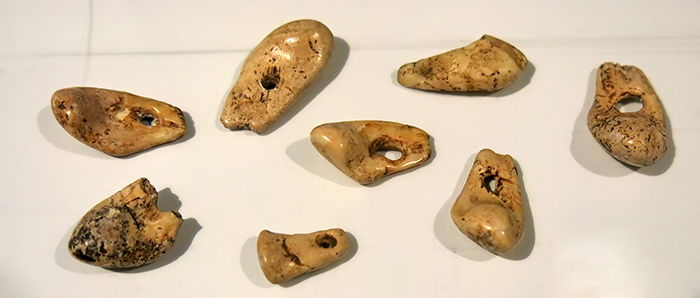
Pierced deer canines
Le Morin
Upper Magdalenian, Magdalenian VI.
On the far right, the deer canine measures 24 mm long, 11 mm wide, and thickness of 2 mm. Catalog 88.47.375.
Beside it, on the upper left, the deer canine measures 20 mm long, 10 mm wide, and thickness of 5 mm. Catalog 88.47.381.
Beside it, on the lower left, the deer canine measures 21 mm long, 12 mm wide, and thickness of 8 mm. Catalog 88.47.378.
The second from the left, on the top, is a deer canine measuring 25 mm long, 11 mm wide, and thickness of 13 mm. Catalog 88.47.376.
On the far left, lower row is a deer canine measuring 18 mm long, 14 mm wide, and thickness of 12 mm. Catalog 88.47.382.
On the far left, top row is a deer canine measuring 25 mm long, 12 mm wide, and thickness of 10 mm. Catalog 88.47.377.
On the second left, lower row is a deer canine measuring 15 mm long, 10 mm wide, and thickness of 6 mm. Catalog 88.47.380.
In the centre of the ring of teeth, the deer canine measures 22 mm long, 12 mm wide, and thickness of 9 mm. Catalog 88.47.379.
Catalog: 88.47.375 to 88.47.382
Photo: Don Hitchcock 2015
Source and text: Original, Musée d'Aquitaine à Bordeaux
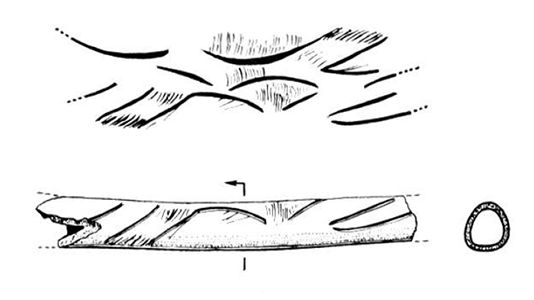
Mesial (middle) fragment of the ulna of a bird. Length 83 mm, width 11 mm.
The decoration consists of curved lines without apparent organisation, including a series of fine shading lines, somewhat comparable to fish-shaped drawings, which could be schematic fins.
Photo and text: Deffarge et al. (1975)
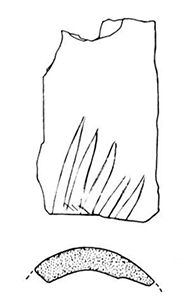
Plant?
Fragment of a large bone. Length 57 mm, width 36 mm.
A light engraving of five finger shapes, elongated and tapering, interrupted by breakage. Perhaps a schematic hand or an aquatic plant (?)
Photo and text: Deffarge et al. (1975)
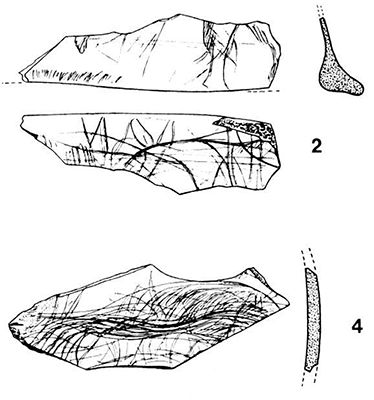
Questionable figures.
No. 2. - Fragment of a scapula. Length 74 mm, width 20 mm. On one face, a series of short, fine lines on the left, and on the right, the drawing of a front leg with hoof, and the coat shown shaded behind that.
On the other side, many superimposed curved lines of varying orientation.
No. 4. - Fragment of a scapula. Length 82 mm, width 29 mm.
A tangle of lines on both faces. The general form on one side may suggest the back of a horse.
Photo and text: Deffarge et al. (1975)
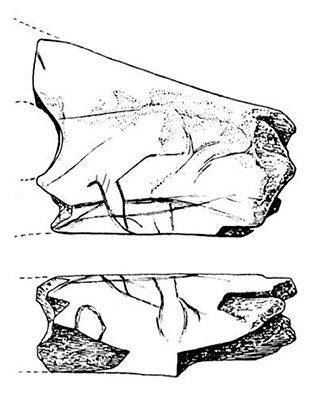
Fragment of a bâton percé in reindeer antler. Length 66 mm, width 45 mm.
The hole of the spear straightener is largely destroyed. Degraded and schematic traces of the forequarters of an unidentifiable animal, with, below, two roughly oval lines.
Photo and text: Deffarge et al. (1975)
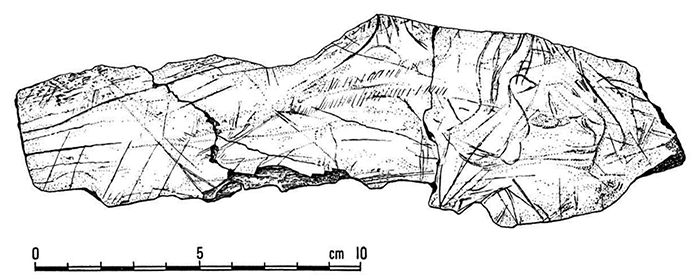
Scapula fragment in three pieces. Length 206 mm, width 65 mm.
In a jumble of sizes, in various depths and orientation, there may be distinguished two series of short oblique shadings, located in the middle.
On the right bison horns are shown in right profile.
Photo and text: Deffarge et al. (1975)
Layer A IV is one of the richest levels of the site.
The horse is the most common subject but certain attributions are dubious. A lack of detail is common. When the animal is repeated in a line, the characteristics of the model are mechanically reproduced.
Although closely contemporary, the horses differ wildly from one to the other in roundness and length of tail and sex. The style is varied, with some being schematic or mechanical representations, while one of the horses is an example of realism with elegant and firm outlines, despite the surprising deformation of the hindquarters.
One of the reindeers is a full engraving, with movement and life which allow it to take its place among the famous works of the upper Magdalenian.
The depictions of deer antlers and the phallic antler may reflect the natural tendency to include the part for the whole, but it is also possible that they reflect practices or rites that escape us. Some identifications of engravings as reptiles and fish remain of questionable validity.
A common technique with these pieces is light engravings and true champlevé technique. As is common, lines of horse are created on spears and a phallus is made from an antler, because of its innate form. With the exception of a bird, scapulas carry engravings which are difficult to interpret, or more often, a meaningless jumble of lines. Bird bones are relatively common. Their smooth hard surface is ideal for creating good engravings, the most realistic animals, and the most elaborate decoration, achievements that required great manual dexterity given the small size of the media.
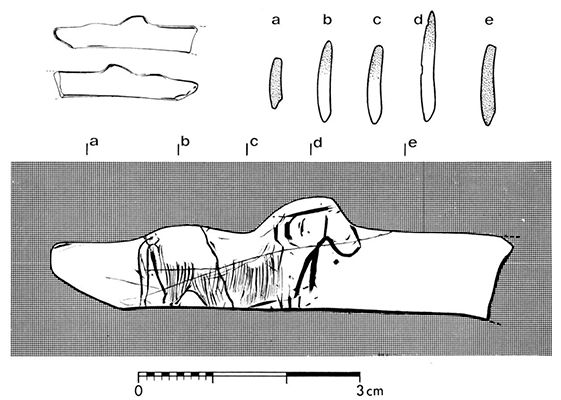
Horse
Flat piece of bone in two pieces, length 59 mm, width 13 mm, thickness 10 mm. The general polishing on both sides, the smooth polished edges, and the shiny polished projections, indicate that this was probably a pendant.
The subject is a horse in right profile, in a static position, well proportioned, designed with care. The outline of the upper part of the animal, the rounding at the root of the tail, which is cut and ground to shape is quite exceptional: the bulge of the mane and curve of the back are clearly marked.
The edge of the bone interrupts the lines of the forelegs, the belly where it would bulge, the hind leg, and the tip of the tail. The head is without details.
Photo and text: Deffarge et al. (1975)

Wide and deep lines may trace perhaps the mane and hair falling on the neck, fine shading shows a detailed coat on the belly and the thigh, making the whole piece very expressively modelled.
Photo and text: Deffarge et al. (1975)

The well set tail is thick, long and hanging. The wide line which starts from the throat in front of the chest suggests a hanging halter, but this interpretation implying the existence of early domestication is therefore questionable.
Text: Deffarge et al. (1975)
Photo: Don Hitchcock 2015
Source: Original, Musée d'Aquitaine à Bordeaux
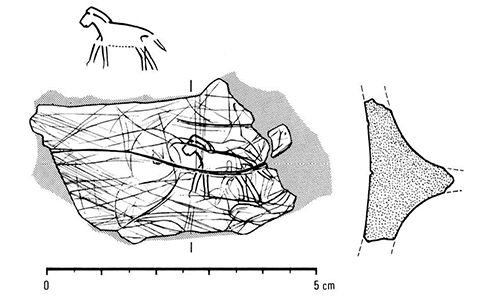
Fragment of a scapula. Length 66 mm, width 31 mm.
In the middle of many tangled lines, there is a small horse in left profile, moving, the legs of each pair clearly separated. A bulge of the outline indicates the mane, and an oblique line traces the neck below the mane. The muzzle is square, the mouth barely marked by a small line. The tail is elongated, tapered, and floating. Extra lines, added after the horse was engraved, intersect its edge.
Photo and text: Deffarge et al. (1975)
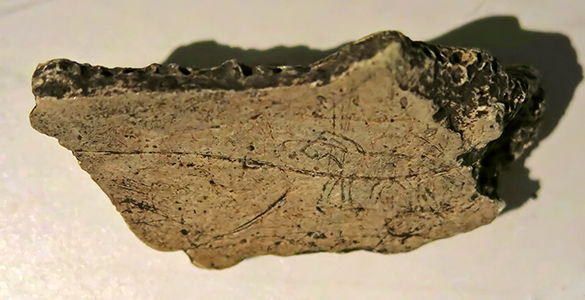
Although it is not much more than a sketch, without details, the horse has been given a remarkable sense of movement, expressed by the position of the legs and the tail. Its style is similar to the Limeuil horses.
(see below for one of these Limeuil horses - Don )
Text: Deffarge et al. (1975)
Photo: Don Hitchcock 2015
Source: Original, Musée d'Aquitaine à Bordeaux
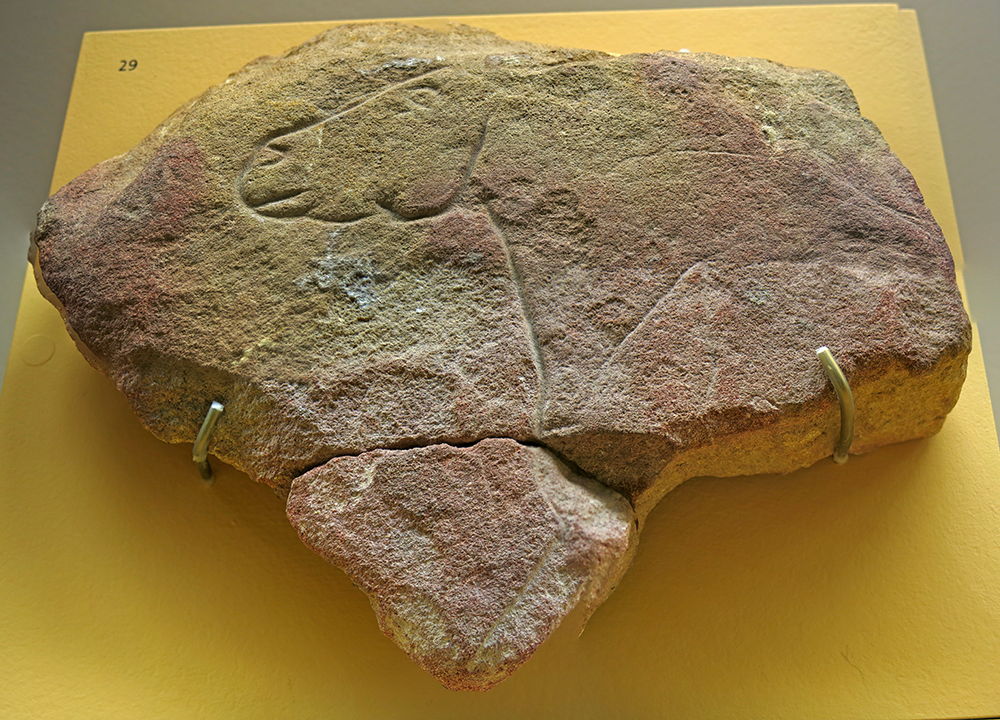
Engraving of a horse, Limeuil
Material: Limestone
Photo: Don Hitchcock 2015
Source: Original, Musée d'Archeologie Nationale et Domaine, St-Germain-en-Laye
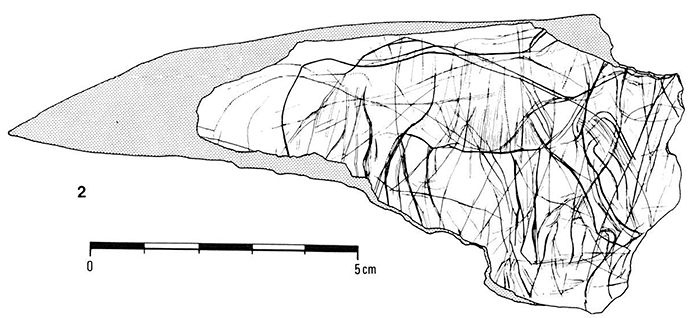
Fragment of a scapula. Length 126 mm, width 51 mm.
In the middle of a tangle of lines, a horse in right profile may be seen, the head missing because of a fracture of the piece. The horse is sturdy and well proportioned, with accurate details: the remnant of a mane, a bulge on the line of the belly probably indicating the penis, and an accurate depiction of the anatomy of the legs.
The design of the right foreleg in particular is strictly in line with reality: the knee between the radius and the cannon, the fetlock, ergot (a small callosity on the back of the fetlock ), pastern (between the fetlock and the top of the hoof ) and hoof; the same for the right hind leg with a well modelled thigh and shin between the leg and the cannon; the left legs in contrast are sketchy in detail.
Photo and text: Deffarge et al. (1975)

The right foreleg is thrown forward while the left remains vertical, indicating the start of movement. The tail is not easy to see. Light lines indicate the coat of the horse and the modelling of the abdomen.
This large stallion is the most realistic and most complete representation of a horse in l'abri Morin. The penis is less well marked than on the stallions from Fontalès and les Combarelles.
Text: Deffarge et al. (1975)
Photo: Don Hitchcock 2015
Source: Original, Musée d'Aquitaine à Bordeaux

Proximal fragment of a baguette demi-ronde in reindeer antler. Length 57 mm, width 14 mm.
The spongy undersurface is flattened, the upper surface is engraved. The engraving consists of an incomplete horse, schematic, in left profile, quickly sketched. The line of the back is slightly saddle backed. The head is partially deteriorated, without details, and with a rounded muzzle.
Between the forequarters and the confused lines denoting the hindquarters, the legs and line of the abdomen are missing. Two parallel horizontal lines probably represent the outstretched tail, and the mane is represented only by a few lines.
Photo and text: Deffarge et al. (1975)
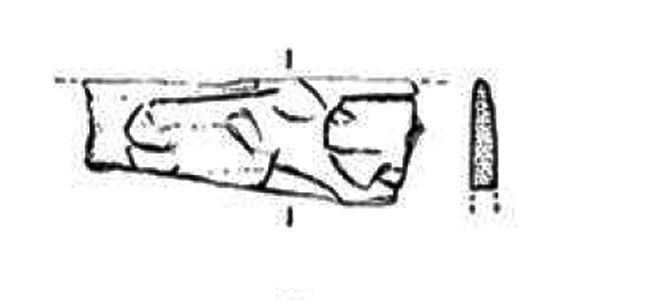
Flat piece of bone, length 32 mm, width 11 mm. This is probably a fragment of a lissoir, a polisher for hides, with the upper edge smoothed.
Two heads of horses in left profile, incomplete: the first is broken at the jawbone; only the front part of the second remains.
Photo and text: Deffarge et al. (1975)
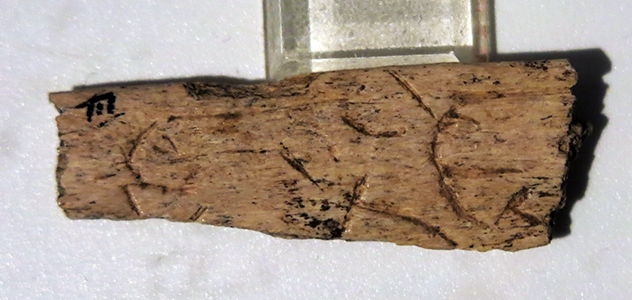
The muzzle of the second head is superimposed on the neck of the first, giving a perspective effect.
Some details are shown: the nostrils, the mouth, and, for the first horse, the eye and perhaps the ear.
Text: Deffarge et al. (1975)
Photo: Don Hitchcock 2015
Source: Original, Musée d'Aquitaine à Bordeaux
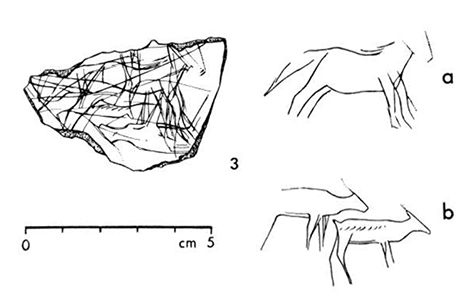
Fragment of a scapula, length 56 mm, width 31 mm.
Amid tangled lines on face 'a' is a horse in right profile: the head is hardly shown; the hind legs are drawn back, the front legs are stretched out ahead; the tapered tail floats in a galloping movement.
Upside down, two schematic deer are shown in right profile. The heads are finely engraved, the antlers are indicated. The first deer, complete, has two legs shown per pair, a short tail and on the flank a line of light shading. The second deer, without hindquarters, has two front legs shown.
Photo and text: Deffarge et al. (1975)
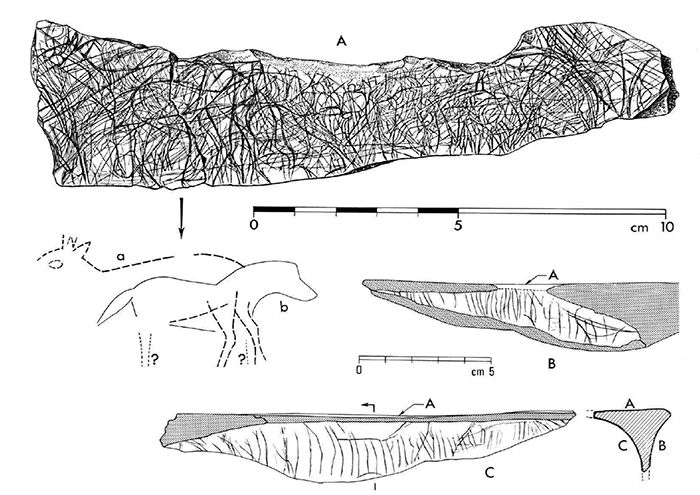
Fragment of a scapula in two pieces. Length 158 mm, width 52 mm.
On segment A and segments B and C, sub-parallel lines.
Photo and text: Deffarge et al. (1975)
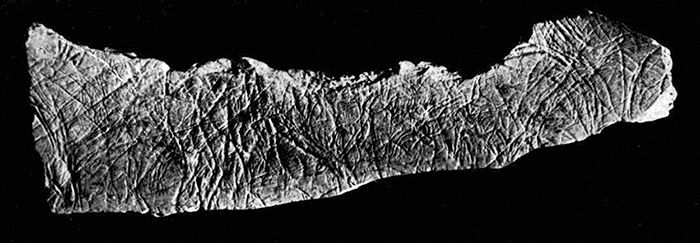
On the underside, it is difficult to interpret an extraordinary tangle of lines on the left of traces of a delicate interpretation: the partial outline of a deer, with oval eyes, ears, hind legs, and the beginning of an antler. There is also the partial outline of a horse.
Photo and text: Deffarge et al. (1975)
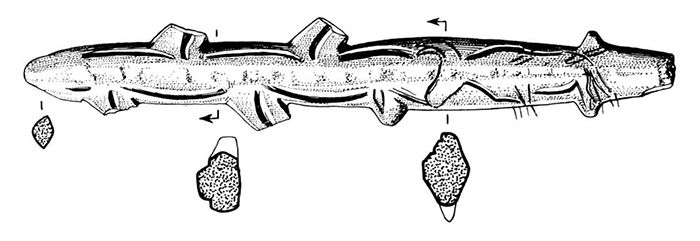
A complete harpoon with two rows of barbs, in two pieces. Length 141 mm. On the upper face of the proximal section of the shaft, there is an exceptional engraving of an aurochs, complete, in left profile. head towards the distal end.
The snout is elongated and rounded. The large horns are turned forward, are in perspective, that on the left partially hiding the one on the right. Deep lines outline the neck, withers, slightly swayed back, as well as the chest and abdomen. The tail is long and hanging.
Photo and text: Deffarge et al. (1975)
The legs are unfinished, but all four are represented. The large head is disproportionate relative to the rest of the body. On the withers and the rump, two lightly engraved chevrons may represent projectile points.
The animal is an aurochs, Bos primigenius, characterised by the elongated head and the shape of the horns. By its silhouette and attitude, it closely approximates the cow and calf of Mas d'Azil, which also carries chevrons on its back. (see below )
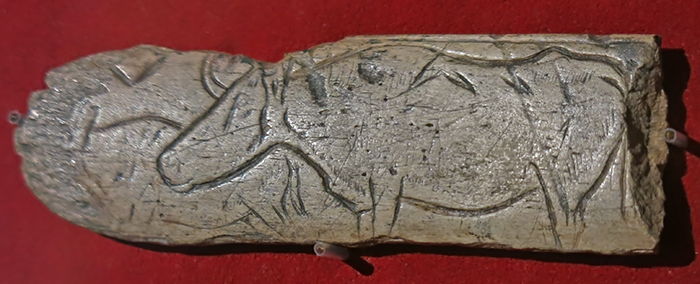
Lissoir or smoother, carved with aurochs and chevrons. Reindeer antler. Grotte du Mas d'Azil. Magdalenian middle / upper. Age 15 000 / 11 000 BP. Excavations of Edouard Piette, 1887-1894.
Text: http://www.spectacles-selection.com/archives/expositions/
fiche_expo_S/saint_germain_salle_piette/salle_piette_visuels.htm
Photo: Don Hitchcock 2015
Source: Original, Musée d'Archeologie Nationale et Domaine, St-Germain-en-Laye, Salle Piette
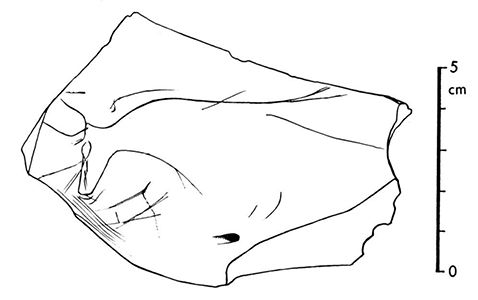
Right humerus fragment of a bovid. Length 98 mm, width 59 mm. Incomplete forequarters of a bovid in left profile.
Photo and text: Deffarge et al. (1975)

Only the head is depicted in detail, tilted as if the animal is grazing, with an elongated square snout, an oval eye, the horns in the shape of a lyre turned forwards, viewed from the front.
The body is only sketchily outlined by the lines of the back and the chest.
Text: Deffarge et al. (1975)
Photo: Don Hitchcock 2015
Source: Original, Musée d'Aquitaine à Bordeaux
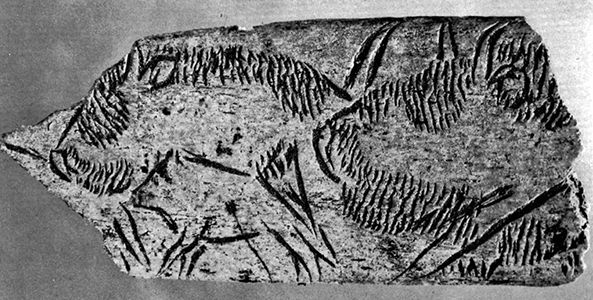
Fragment of a flat bone. Length 47 mm, width 20 mm. The lower side is flattened, the edges are rounded, the faces are polished. This is undoubtedly a fragment of a lissoir, used for working hides.
Two adult bison in left profile follow each other in line, with a small animal superimposed on the first. The first adult is only partially visible, hidden as it is by the small animal and by the head of the second adult which overlaps the hindquarters of the first. A break has destroyed the body of the second bison. These bison were created by a process of lines and shadings. The lines are reserved for the parts of the body which are more or less hairless, including the ears, horns, muzzles, nostrils, as well as the upright tail of the first and left foreleg of the second.
Photo and text: Deffarge et al. (1975)
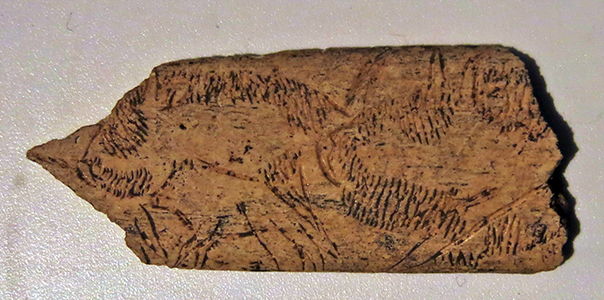
Short lines form the tangled mane, the coat, and the hair on the back, forehead, abdomen and the flank. The head of the second animal is of an excessive size, and is disproportionate, and the leg thrust forward is badly placed.
Despite these anatomical blunders, the massive, shaggy appearance of the animals is rendered with stunning realism.
The contrast is striking between these adult bison and the animal in the foreground, since its reduced dimensions demonstrate it to be a juvenile: there is no shading to indicate the hairs of the coat, and no horns. The head is stocky, the eye, ear and nostril are indicated, the muzzle is square, the forequarters are massive. A walking motion is expressed by the forelegs being thrust forward and by the position of the tail and the left hind leg thrust back.
Text: Deffarge et al. (1975)
Photo: Don Hitchcock 2015
Source: Original, Musée d'Aquitaine à Bordeaux
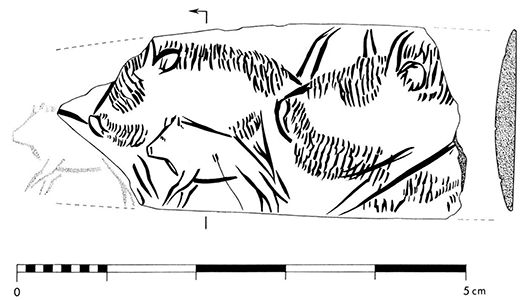
A small area scraped on the flank and a fine line may indicate a bleeding wound. The identification of this small animal remains problematic. Its proportions, its silhouette, the shape of its nose, and the absence of horns are more likely to make one think of a boar than a small bison walking in the herd.
But in portable art, lines of animals almost always consist of animals of the same species. Also, in nature, it is often difficult to recognise the young of a species.
In front of this small animal, various dashed lines probably correspond to the hindquarters of another small animal, as proposed in the drawing.
Photo and text: Deffarge et al. (1975)
Regardless of any interpretation on our part, this engraving certainly combines two adult bison, and a young animal, either a bison or a boar. Examples of such coexistence are exceptional and uncertain:
• The cow and her calf (now thought to be a young bison, see below - Don ) from Mas-d'Azil
• The mare and foal from Laugerie Basse and Lespugue
• The female bison and young from Brassempouy
• The bone rondelles from Laugerie Basse, a cow and calf and a chamois and its young. (One of these may be the rondelle below from Laugerie Basse - Don )
These attributions of adult and young are based mostly on the size difference between adults and their young, and on the more vague and subjective attitude and behaviour. The juvenile shown here from l'abri Morin is actually the only indisputable case: it is in the foreground, and its dimensions are considerably smaller than those of the bison in the background. The fragmentary state of the object which displays a line of animals is all the more regrettable given these attributes.
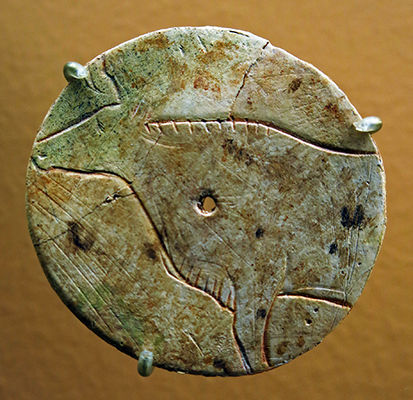
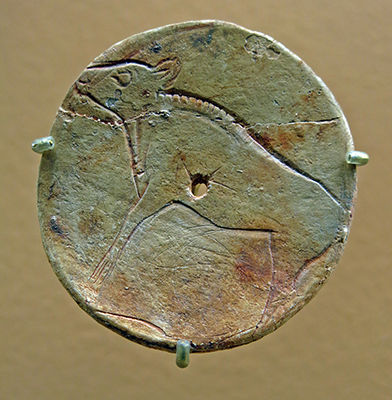
Engraving of an aurochs and a bison from Mas d'Azil.
Some say that this may have been used as a button, the two sides are quite different. (I believe that this, and all similar rondelles are weights for drop spindles for spinning yarn - Don ) The one on the left depicts an adult aurochs considered a female because of the fine features of the head. The withers and chest are marked with small incisions. Horns and ears are sketched. The eye and the nostril are shown as points.
The other side of the disk shows a young bison, which, according to the size of the horn and the curvature of the hump might be about five months old. This young bison is half the size of the adult animal. Again, we find the same incisions along the shoulder and the chest. Aurochs females sometimes adopted baby bison.(I assume similar behaviour between cattle and bison has been recorded in zoos - Don )
Text: http://www.musee-archeologienationale.fr/template.php?SPAGE=2276
Photo: Don Hitchcock 2014
Source: Facsimile, Musée d'Archeologie Nationale et Domaine, St-Germain-en-Laye
Photo and French text: Visiter les Abris de Laugerie-Basse - Alain Roussot - Editions Sud-Ouest.
My thanks to Anya for access to this resource.
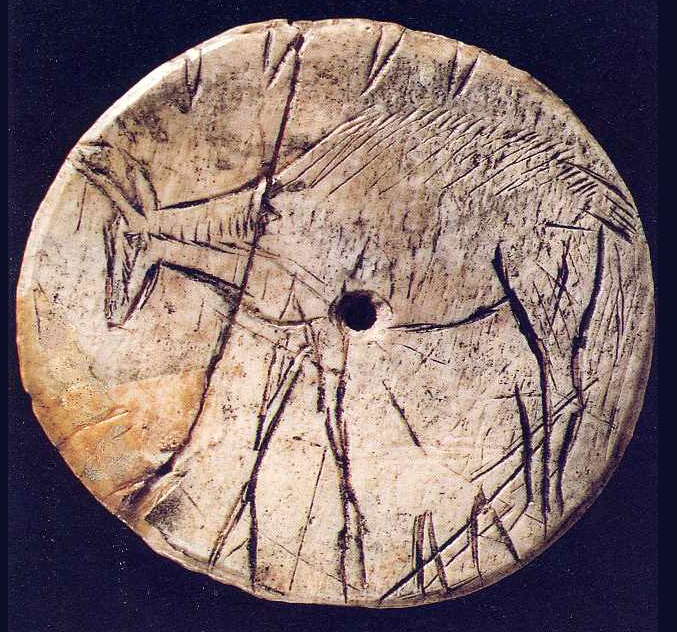
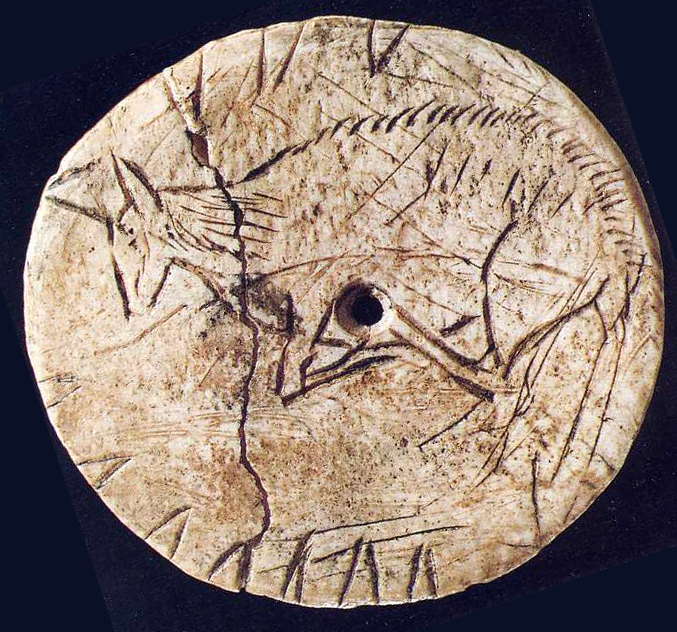 Very thin disc from Laugerie Basse in bone, 31 mm. in diameter, perforated in its centre, with on each face the representation of a herbivore (deer?) and chevrons along the edges.
This miniature work of art was discovered in 1868 by M. Hardy and was published for the first time in 1872 in 'Le Magasin pittoresque', a popular review of the time.
Very thin disc from Laugerie Basse in bone, 31 mm. in diameter, perforated in its centre, with on each face the representation of a herbivore (deer?) and chevrons along the edges.
This miniature work of art was discovered in 1868 by M. Hardy and was published for the first time in 1872 in 'Le Magasin pittoresque', a popular review of the time.
Click either of these images to see an animation.
It may have been a button, with a leather thong through the hole, knotted at the end. (I believe that this, and all similar rondelles are weights for drop spindles for spinning yarn - Don )
Animation by Don Hitchcock.
Photo: Visiter les Abris de Laugerie-Basse - Alain Roussot - Editions Sud-Ouest, my thanks to Anya for access to this resource.

Fragment of a flat piece of bone, crumbling at one end, broken at the other. Length 76 mm, width 15 mm.
Of oblong shape and lenticular cross section, the edges are rounded, the faces polished, with traces of longitudinal scraping. This object has a narrowing (anneau) along its length, allowing it to be suspended, as in some of the Fontalès artefacts, and it seems to be a fragment of a piece of the same type. On face A, there is a bison in right profile. the forequarters are poorly drawn.
Photo and text: Deffarge et al. (1975)
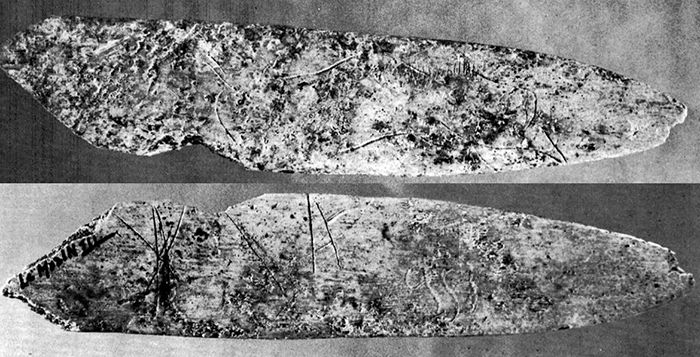
The head is abnormally elongated, and it is disproportionate with the indication of the horn and of the nostril and has perhaps a triangular beard. Some shading indicates the mane. The hump on the back is large. Despite the lack of care in the drawing, the movement of the animal which seems to be running or perhaps jumping is remarkably expressed by the head and the front leg thrust forward, the body stretched by the effort, and the tail elevated.
On face B, the forequarters of the bison are shown very schematically in left profile, arranged inversely compared with the previous engraving. The geometric style of this drawing detracts from its realism. One can distinguish two twisted horns, an ear, two stiff legs shown by converging lines. On the left, at a distance, some lines are grouped without obvious meaning.
Photo and text: Deffarge et al. (1975)
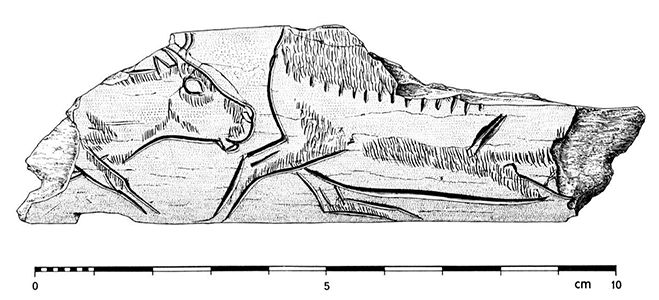
Fragment of a split rib. Length 108 mm, width 32 mm. The underside spongy surface has been flattened and rounded at the edges, is engraved with four pairs of oblique lines. The upper face consisting of an engraving of two reindeer following each other. They are shown in right profile, and are incomplete. The first is lacking the forequarters and part of the back because of a break in the bone, and the second lacks all features behind the shoulders.
The first has a rounded thigh, the hind legs are incomplete, with well drawn shanks and on the leg an oblique line which is outlines the achilles tendon. Behind the shoulder, a wide double line may represent a projectile.
Photo and text: Deffarge et al. (1975)
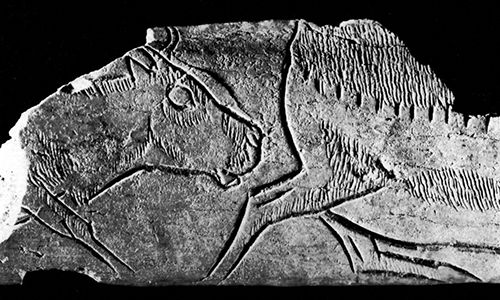
The right leg is directed towards the front, the left leg backwards in a walking motion. Short and fine shading lines indicate the coat on the rump, the thigh and the legs. On the belly they may perhaps indicate the lower limit of the dark hair of the coat.
Some wide pits, deep, spread out, aligned on the thigh and the flank correspond to age spots or hair tufts.
(these are in fact a normal part of reindeer physiology, and are called 'Pepper's Patches' - see below - Don )
Photo and text: Deffarge et al. (1975)
The head of the second reindeer is complete, except for the antler, of which only the base remains. Stretched forward, it is depicted with great realism of the details: the thick muzzle, the precise design of the nostrils and mouth, the bulging forehead, the eye with the tear duct, and the short, sharp ear.
On the chest is indicated a bulging dewlap, with a thatching of hair. Other hair patches are scattered on the muzzle, around the eyes, on the forehead, cheek, back and neck, and on the leg. Unfinished, the right foreleg, with well marked knee and achilles tendon, is projected forward.
This scene is very similar to the two reindeer following each other from la Madeleine (see below ), with the second beasts nearly identical. It is not certain whether the following animal at la Madeleine is a young with emerging antlers.
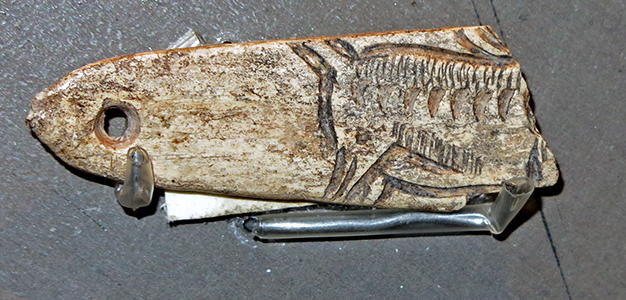
Pendant engraved with what may be the hindquarters of reindeer cow. Note, however, the line of decorative notches carved along the flanks of the animal. These are known as Pepper's Patches, and occur mostly on young and on female reindeer.
Label:
Pendeloque gravée
Laugerie-Basse, Fouilles Hardy
Périgueux, Musée d’art et d’archéologie du Périgord
Pr.A. 1902
Photo: Don Hitchcock 2014
Source: Musée d’art et d’archéologie du Périgord, Périgueux
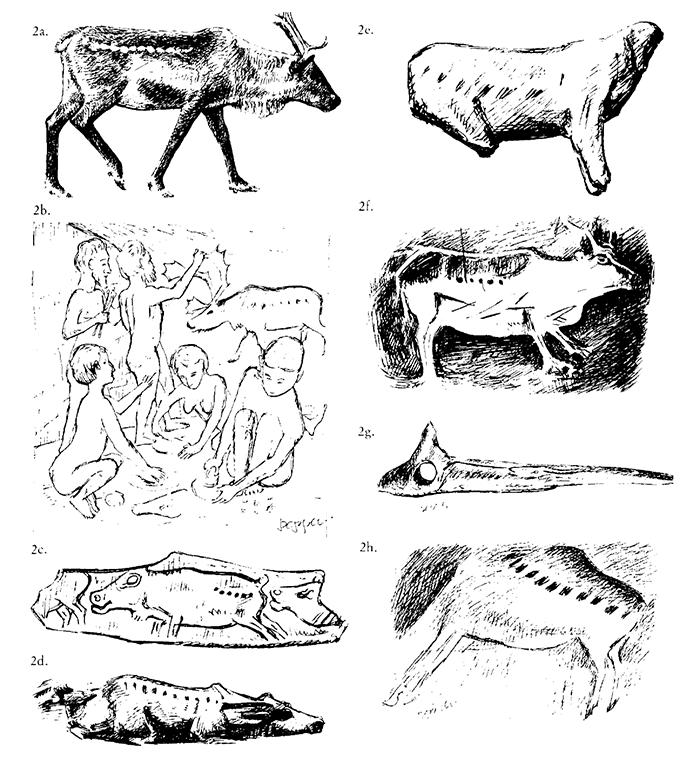
Pepper's Patches
a. Rangifer t. tarandus. ♀. Whipsnade Zoo. Sketch by H.P. (Hubert Pepper), 1982.
b. 'Grinding ochre and painting frescoes on rock'. Redrawn by H.P. from Breuil (1949)
c. Reindeer engraved on bone, Massât; Ariège, France. Musée Ste. Germaine, Paris. Sketch by H.P.
d. Reindeer sculptured in ivory; Bruniquel. British Museum, London. Redrawn by H.P. from Graziosi (1960)
e. Reindeer carved on antler spear-thrower; Arudy. Musée Ste. Germaine, Paris. Redrawn by H.P. from Graziosi (1960)
f. Rock wall painting; Les Trois Frères, near Montesguion, Arantés, Ariège, France. Redrawn by H.P. from Leroi-Gourhan (1968)
g. Female reindeer on 'bâton de commandment'; Laugerie Basse. Redrawn by H.P. from Graziosi (1960)
h. 'Spotted Reindeer'; La Mouthe. Redrawn by H.P. from Breuil (1952)
Photo and text: Pruitt and Pepper (1986)
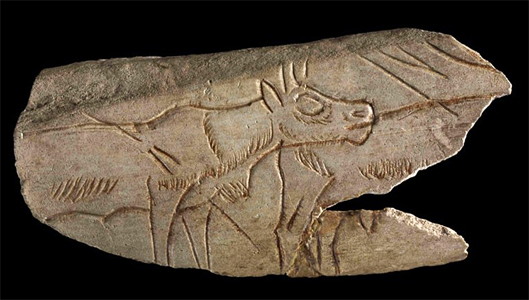
Fragment of decorated reindeer metatarsal (bone) engraved on the obverse surface with two reindeer, one of which is now incomplete; decorated bone; Palaeolithic; Madeleine, France.
Photo: © The Trustees of the British Museum
Text: http://www.telegraph.co.uk/culture/culturepicturegalleries/9847457/Ice-Age-Art-in-pictures.html?frame=2470431
The same conventions are found in the line of reindeer from a decorated bone found at Massat (see below ): The tuft of hair at the dewlap, the muscular line of the legs, marks on the flank. The subject, the attitude, the processes therefore covered a wide geographical area, which does not detract fromt the qualities of life and movement of these works.
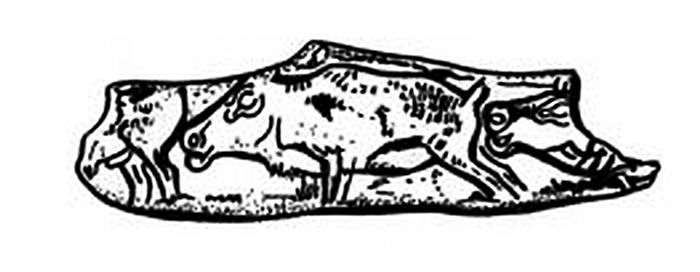
Small bone fragment from Massat, France. It shows a cow reindeer urinating for a bull. Cows in or nearing estrus spread their legs and urinate for a sexually aggressive male.
If the signifying hormones are absent, it deters further aggressive insistence from the male, but if these potent estrous pheromones are present, they encourage further attraction.
Photo and text: Vrba and Schaller (2000)
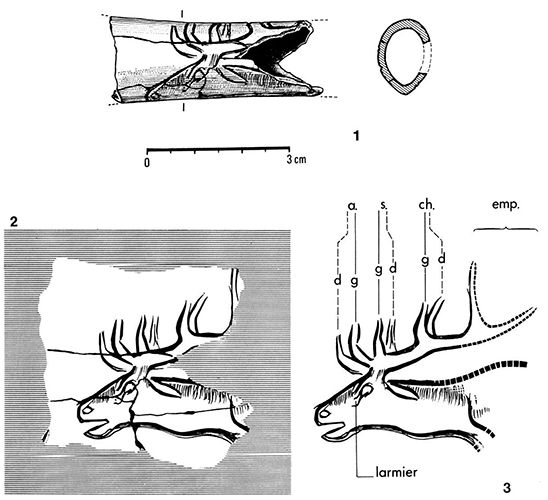
Mesial (middle) fragment of a large bird bone. Length 46 mm.
Head of a bellowing deer in left profile. The neck is outstretched, the ear laid back, the mouth open, nostrils dilated, the antlers thrown back. To these details which strikingly express movement is added the anatomical accuracy of the eye with a well drawn tear duct.
There is some shading indicating fur on the muzzle/forehead and neck, which may indicate the mane of coarse hair which is common during rut.
Photo and text: Deffarge et al. (1975)
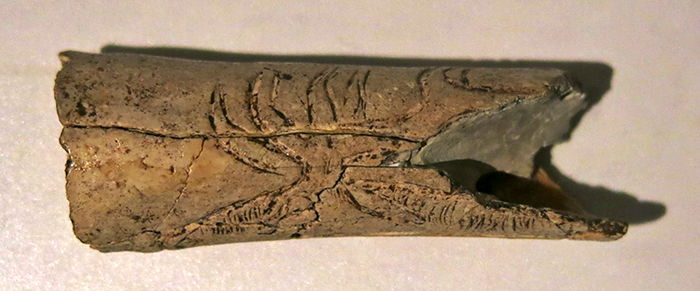
The antlers allow us to determine the age of the animal: it is an adult individual in at least its fifth year (if there are four sets of points) or sixth year (five sets, ten points). The lack of the continuation of the engraving does not allow us to identify the age more accurately.
Palaeolithic artists preferred to show deer horns with ten points or more.
Text: Deffarge et al. (1975)
Photo: Don Hitchcock 2015
Source: Original, display at Musée d'Aquitaine à Bordeaux
The theme of a bellowing deer with large or even excessively large antlers is as well known in portable art as it is in wall art. The methods used to evoke this characteristic attitude are always the same, but, apparently, more easily for isolated individuals, and as in the deer of l'abri Morin, with a more vibrant realism.
The choice of this classic theme may be related to hunting magic or simply to familiar hunting events. The rut, the time of the stags bellowing, lasts from mid-September to late October. During this period, the approach to game is easier because the deer can be heard and followed, and it may be possible to encourage them to respond using a decoy, and because they are less suspicious and less cautious than usual.
It is also the case that at the time of the rut, the antlers, raw material for weapons and tools including hammers, are of the highest quality, more compact and hard, which is directly related to the secretion of hormones at this time. The use of antlers for tools ends at the end of summer. Shed antlers, from moulting deer in February, are demineralised and not as strong, they break easily.

Two fragments of the same piece of bone. Length A 50 mm, length B 58 mm. These pieces are not connected, but obviously belong to the same object, as shown by the identity of the subject, technique and the style of the engravings.
Fragment A is of a deer in left profile, very partial. There remains a part of the relatively large head, tense and leaning forward with a rounded snout, the lower lip swollen, the line of the nostrils and mouth.
Photo and text: Deffarge et al. (1975)
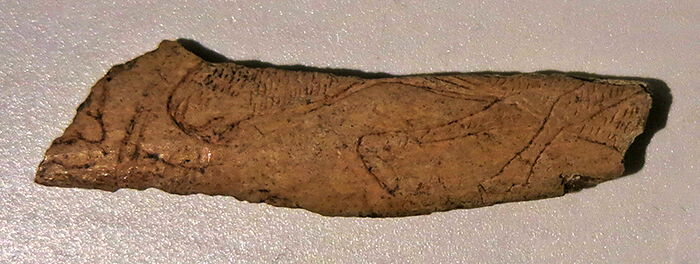
The front legs are too short, and are thrown forward, the right stiff, with the foot bent back, and the left has an angular knee, a narrowed cannon bone, a projecting sesamoid bone and pointed hoof. Except for the feet and left cannon, the animal is covered with shading.
Photo: Don Hitchcock 2015
Source: Original, display at Musée d'Aquitaine à Bordeaux

On fragment B, the hind legs of a deer belong to the previous animal. Like the forelegs, they have projecting sesamoid bones and pointed hooves. They are thrown back, but are folded in an unnatural position and appear disjointed. This convention of movement and head position express the speed of running, perhaps a gallop, but in a quite exceptional representation.
Photo: Don Hitchcock 2015
Source: Original, display at Musée d'Aquitaine à Bordeaux
On the right there is the head of a young ruminant in left profile, covered with shading except for the eye. Its rounded snout, with the bulbous lower lip and the line used for the mouth and the nostril, is identical to that of the deer of side A. This isolated head is defined at the location of the neck by lines without apparent meaning.
Similarly without explanation is a shaded area like a pelt, between the legs and the head, and on the far right is the tracing of spindle shapes partially destroyed by the break.
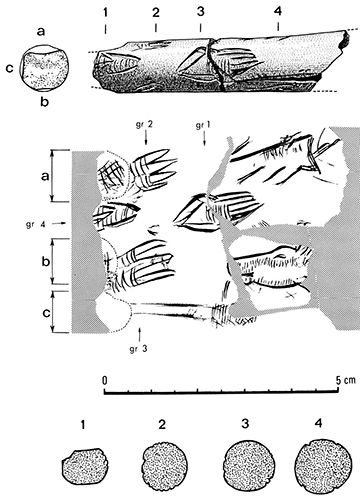
Fragment of the middle part of a reindeer antler, in three pieces. Length 55 mm, width 12 mm. At one end, three flat areas of which the two opposite each other, 'a' and 'b' on the drawing, are striated, while the third side, 'c' is smooth.
Several engravings are unevenly distributed on the piece, with no apparent order: a deer head and several groups of lines. The head is mutilated, the nose is damaged, the ear broken; the forehead is curved, the eye and the mouth are represented by lines, the coat by two sets of shadings. The groups of lines (1 to 4) have in common longitudinal lines, which converge into fingers, and a series of transversal shadings. Their interpretation remains hypothetical. The fingers of groups 1, 2, and 3, despite their number, shape and somewhat different layout, are reminiscent of claws.
Among the large mammals, only the bear has long non-retractable claws, but flattened transversely; their shape differs from these figures, especially group 2. They compare more easily to the forelegs of burrowing animals such as moles, or tortoise legs. The cross-hatching could represent either the granulous nature of the skin, or skin folds in the first case and the scales in the second. These animals having five claws, these representations of only three or four claws result from a simplified fingering mental approach, such as in the case of hands with four fingers.
Interpreted as a schematisation of fish, a figure from l'abri Murât shelter with fingers and horizontal lines has also been seen as a leg or a bear paw print. Whatever their meaning, the combination of these elements with a realistic schematic animal head remains unexplained.
Photo and text: Deffarge et al. (1975)
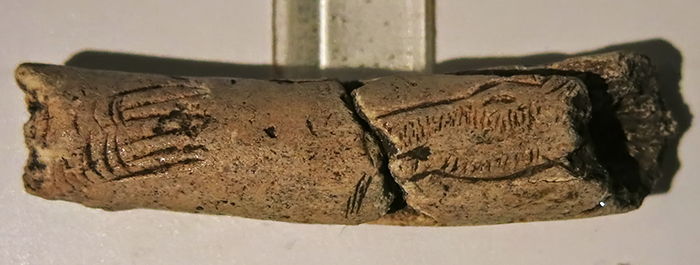
Among the large mammals, only the bear has long non-retractable claws, but flattened transversely; their shape differs from these figures, especially group 2. They compare more easily to the forelegs of burrowing animals such as moles, or tortoise legs. The cross-hatching could represent either the granulous nature of the skin, or skin folds in the first case and the scales in the second. These animals having five claws, these representations of only three or four claws result from a simplified fingering mental approach, such as in the case of hands with four fingers.
Text: Deffarge et al. (1975)
Photo: Don Hitchcock 2015
Source: Original, display at Musée d'Aquitaine à Bordeaux
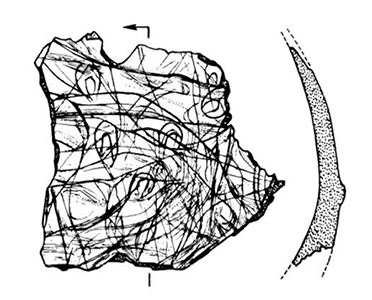
Skull bone fragment. Length 66 mm, width 56 mm. A tangle of lines covers both sides of the piece. On the concave face are six figures shaped like horseshoes, arranged in no apparent order. They are comparable to the signs engraved on stone blocks of various Perigord shelters, which are conventionally interpreted as vulvas, including an oval sign of the Aurignacian II from la Ferrassie. However, in general, the Aurignacian vulvas are not oval but more or less triangular. (see below - Don )
Figures from l'abri Morin are also very close to the engraving of 'two ovals nested one inside the other' from la Groze à Gontran which belongs to the first type of female oval signs distinguished in wall art by
A. Leroi-Gourhan. Their multiplicity and random distribution are exceptional. They also recall the vulvas in line on a bâton of reindeer antler from the upper Magdalenian of the Roc du Marcamps. (see below - Don )
Photo and text: Deffarge et al. (1975)
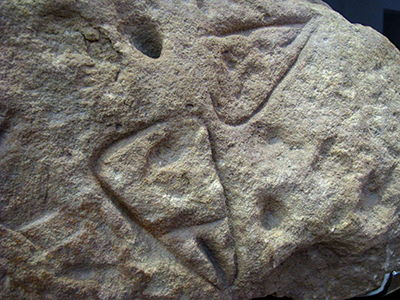
La Ferrassie, aurignacian engravings of vulvas in a triangular format, and cupules.
Photo: Don Hitchcock 2008
Source: Original, display at Musée National de Préhistoire, Les Eyzies

This is the bâton of reindeer antler with vulvas in line from Roc du Marcamps referred to above. It illustrates well the shape of the vulvas which the artists drew. In this example, the vulvas are also rounded as in the bone fragment above, but they are not horseshoe shaped. Instead they are all carefully engraved with a V shaped incision.
Photo: Don Hitchcock 2015
Source: Original, display at Musée d'Aquitaine à Bordeaux

Upper Magdalenian (VI) bone needles from le Morin, and a needle smoother/polisher.
From the collection of René Deffarge.
Photo: Don Hitchcock 2015
Catalog: 88.47.245, 1055 and 1311 to 1315
Source: Original, display at Musée d'Aquitaine à Bordeaux
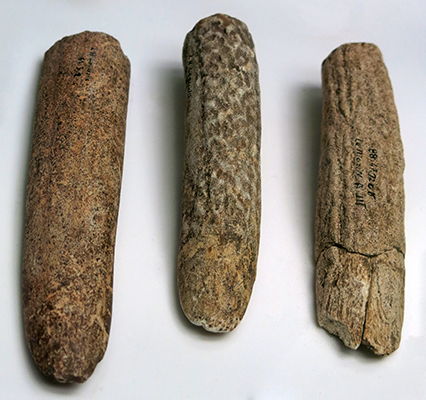
Ciseaux massifs (literally translated, massive chisels) from Laugerie Haute and le Morin. These may have been used as lissoirs (working hides), for flensing (removing the skin of game) or for splitting small pieces of wood.
(left) Ciseau, reindeer antler, length 135 mm, width 31 mm, thickness 17 mm, Laugerie Haute.
(centre) Ciseau, deer antler, length 118 mm, width 26 mm, thickness 21 mm, Laugerie Haute.
(right) Ciseau, le Morin, number 8 from level A III, page 91, Deffarge et al. (1974)
Photo: Don Hitchcock 2015
Catalog: (left) 61.3.42, (centre) 61.3.43, (right) 88.47.1206
Source: Original, Musée d'Aquitaine à Bordeaux

Massive ciseaux (literally translated, massive chisels) from le Morin. These may have been used as lissoirs (working hides), for flensing (removing the skin of game) or for splitting small pieces of wood.
Ciseau, le Morin, Deffarge et al. (1974)
Photo: Don Hitchcock 2015
Catalog: 88.47.1205, 88.47.1206, 88.47.1209
Source: Original, Musée d'Aquitaine à Bordeaux
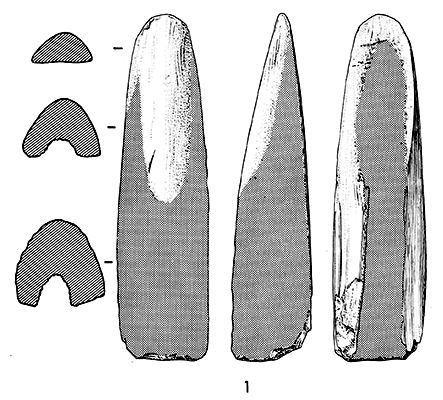
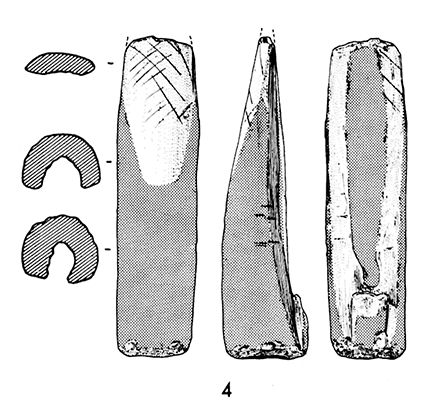
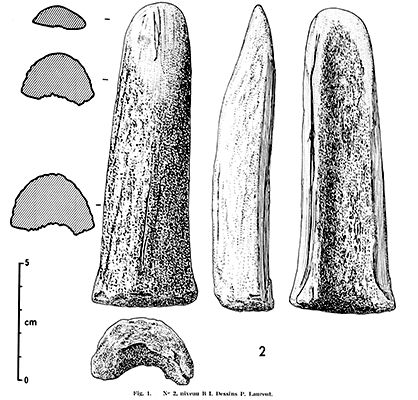
Ciseau, le Morin, Fig 1, No 1, Layer A III, the ciseau on the left in the colour photo above, Catalog 88.47.1209 in Musée d'Aquitaine à Bordeaux.
Ciseau, le Morin, Fig 2, No 4, Layer A III, the ciseau in the middle in the colour photo above, Catalog 88.47.1205 in Musée d'Aquitaine à Bordeaux.
Ciseau, le Morin, Fig 1, No 2, Layer B I, the ciseau on the right in the colour photo above, possibly Catalog 88.47.1206 in Musée d'Aquitaine à Bordeaux.
Photo: Drawing by P. Laurent
Source: Deffarge et al. (1974)
As in the previous level, the horse is the species by far the best represented in the rich level A III. In addition to simple sketches, partial or even questionable, there are some success stories: a well proportioned horse, a small horse full of movement, and a beautifully drawn stallion.
The traditional reindeer themes, and the bellowing deer, are treated according to conventional methods, with life and realism. The haggy bison with young, are by contrast against original, both by subject and by style. With isolated legs whose identification is not possible, the level has delivered exceptional representations because of the multiple representations of claws and vulvas.
The plant motifs are as always problematical to identify. The media used are exceptional: the skull bone with vulvas, and harpoons with realistic engravings of bovids and fish. Pendants or lissoirs are relatively common.
As in level A IV, it is a bird bone which bears one of the best engravings of this layer, a bellowing deer. Except for the little horse and the stallion, the shoulder blades are engraved with incomplete figures or ones difficult to interpret, often in a tangle of lines. The procedure of partial découpé contour ( a partially cut out shape) of the pendant showing the horse in right profile is quite exceptional.
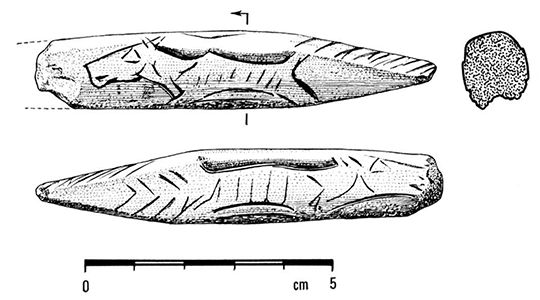
Proximal fragment of a spearhead (i.e. the end closest to the shaft to which the spear head is attached )
Length 81 mm, width 10 mm. Shaft is sub-quadrangular in section, with a rounded base with a double very slightly curved bevel, ribbed on both sides by eight oblique lines, now almost gone from the spongy underside.
(Note that this grooving is normal for all bevelled sagaies, or spear heads. The oblique grooves are there to help the adhesion of the birch bark glue used to attach the spear head to the shaft of the dart. You can make your own birch bark glue by following the instructions at http://www.jonsbushcraft.com/birchtar.htm - Don )
Photo and text: Deffarge et al. (1975)
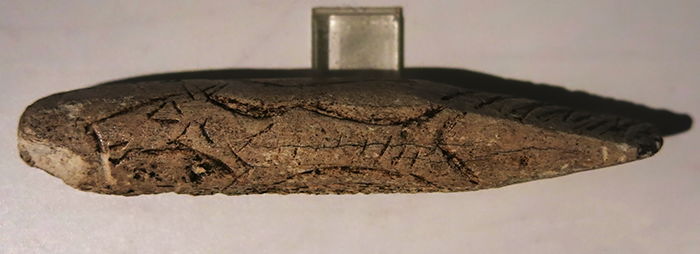
On each side, there is an engraving of a horse that is probably the last in a line of such horses (a common motif ). On the left side, a horse in left profile galloping, head and neck outstretched, the front leg projected forward, the hind leg back, the body stretched out, the tail up. The head and neck are disproportionately large, with a length almost equal to the total length, and schematic, the body shrunken, almost scrawny.
Text: Deffarge et al. (1975)
Photo: Don Hitchcock 2015
Source: Original, display at Musée d'Aquitaine à Bordeaux
The muzzle is square, the lower lip swollen; well separated ears are represented by two lines each, the mouth by a short line, the nostril by a thick line (on the second horse ), the large eye by a triangle of three lines, the jawbone by a curved line; the wide neck bears an oblique line. An angular line marks the withers, a broken line the shoulder, a concave line the stomach.
The tail and legs are ended abruptly, as if their engraved lines, prior to the final manufacture of the spear, was partially destroyed by the cutting of the bevel and possibly the underside. Eight thin oblique shadings probably represent the coat of the horse.
The details are similar for the two horses: the separate ears, triangular eye, the line of the cheek, the start of the tail up, the line of the belly concave and body coat shown by shading. The legs have deteriorated. At the bevel of the spears, three chevrons show schematically, (on the second horse ) perhaps by repeating it, the stylised profile of the hindquarters.

Proximal fragment of a spear point. Length 60 mm, width 13 mm. The shaft is quadrangular in section, with an eroded double bevel smooth base. On each side, starting inside the bevel and extending to the shaft, a horse has been engraved in the champlevé style, (with a deep groove surrounding the outline to give an impression of high relief - Don )
The outline of the abdomen and the hooves was destroyed by the subsequent cutting of the bevel and the lower face. The two figures, in right profile on the right side and left profile on the left, are virtually identical.
Photo and text: Deffarge et al. (1975)

The head, with the muzzle slightly damaged by the break, is elongated and stretched out. Lines delineate the nostrils, the mouth, the relief of the cheek, two lines the oval eye, two others the erect ear, and an oblique line on the neck shows the edge of the mane. The outline is realistic: a large mane, the back curved in the normal manner, the line of the rump.
Text: Deffarge et al. (1975)
Photo: Don Hitchcock 2015
Source: Original, display at Musée d'Aquitaine à Bordeaux
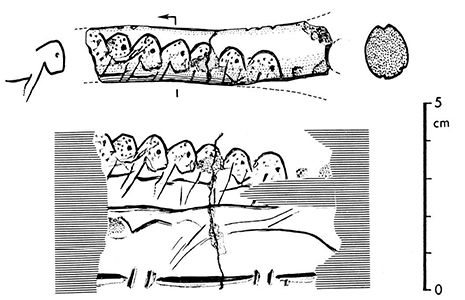
Fragment of a bâton percé, 73 mm long, of reindeer antler in two pieces. A small part of the original hole in the spear straightener remains.
There is a line of seven heads in right profile, the first and the last partially damaged. They have common characteristics: the skull is rounded, the round eye lies in a depression or cupule, the muzzle is square. There are pock marks unevenly distributed on the top of each head.
A line from the throat of the fourth head to the fifth head is reinforced by a parallel line which is perhaps a clumsily drawn chest; longitudinal lines arranged around these lines perhaps depict the abdomen. Another line on the piece may represent ground level. Separate from the line of animals are three deep longitudinal incisions, separated by two groups of two short transverse lines, to which no meaning can be assigned.
These badly proportioned figures, their general appearance summarily sketched, are lacking critical anatomical features. Should we identify them as horses, because they evoke a herd, or should we classify them as feline, perhaps as panthers with spotted coats, which Leroi-Gourhan identified them as?
Photo and text: Deffarge et al. (1975)

In a strange way, they remind the viewer of Danish or Dalmatian dogs. By their layout and schematics, they are reminiscent of the horses of Chaffaud, which are, however, more detailed and lifelike. By comparison, the line of animals from l'abri Morin has a manifest paucity of artistic expression.
Text: Deffarge et al. (1975)
Photo: Don Hitchcock 2015
Source: Original, display at Musée d'Aquitaine à Bordeaux
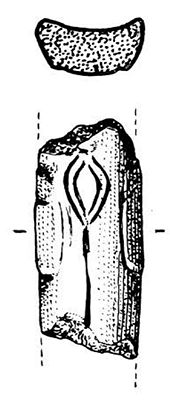
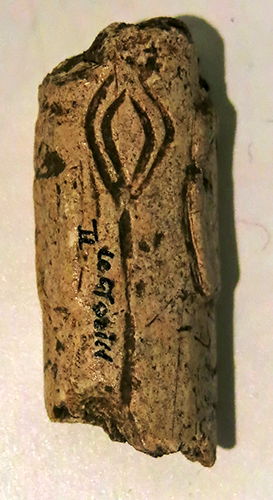
Mesial (middle) fragment of a worked reindeer antler, very deteriorated in its spongy part. Length 37 mm, width 16 mm.
On both sides appear apparently meaningless reliefs in the champlevé style (a deep groove surrounding the design giving the impression of three dimensionality - Don )
On the upper side, two nested rhomboids with a longitudinal line appear, perhaps representing a stylised snake head.
Age: Upper Magdalenian, Magdalenian VI
Photo (left) and text: Deffarge et al. (1975)
Photo (right): Don Hitchcock 2015
Source: Original, display at Musée d'Aquitaine à Bordeaux

The end of a deer antler, shaped into a phallus. Length 78 mm.
The distal portion is created by scraping to create a phallus-shaped peripheral bulge.
(this phallus is almost identical to the one above from Layer A IV - Don )
Photo and text: Deffarge et al. (1975)
The horse is the only clearly represented animal in this layer, A II, which has a paucity of art objects. The horse appears in a traditional line of animals, in a rather schematic style on spear points, and perhaps in a line of heads. The deep etching of some pieces, the use of champlevé, and an antler in the shape of a phallus should be noted.
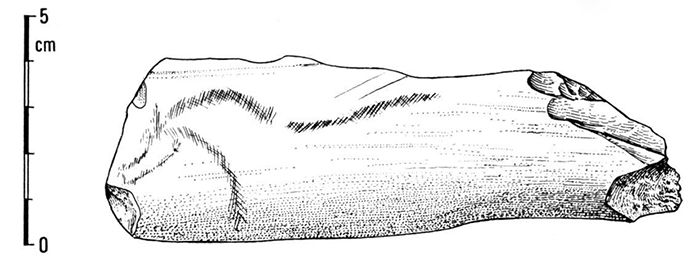
Bone fragment, length 136 mm, width 37 mm. Horse in left profile, deliberately unfinished, with just the head, neck, chest and back delineated.
The technique is original. The outline is expressed only by hatching or shading, sometimes with intersecting lines, especially on the chest. The head is narrow, elongated, and distorted. Some of the lines may represent an ear. The mane is rounded, the back swayed. This is an evocative sketch.
Photo and text: Deffarge et al. (1975)

Note that on this colour photograph, the head of the horse is not so obvious as it is on the drawing above.
Photo: Don Hitchcock 2015
Source: Original, display at Musée d'Aquitaine à Bordeaux
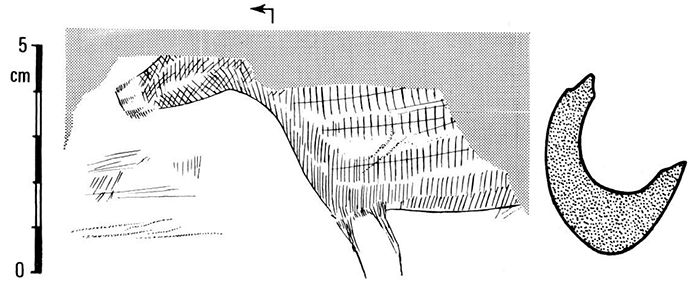
Fragment of a large bovine left radius. Length 135 mm, width 40 mm. A break has removed part of an engraving of a bovid in left profile, of which the forequarters remain. The snout is elongated and square, the body is massive, with slender legs, short and tapering.
Photo and text: Deffarge et al. (1975)
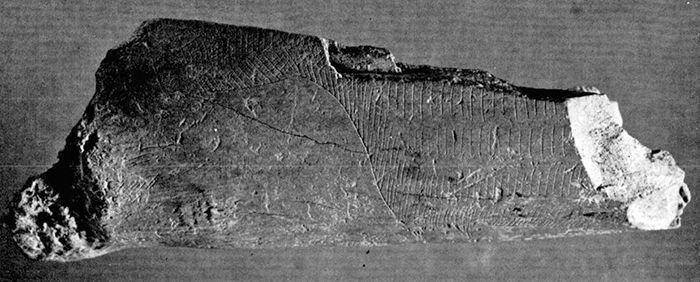
The technique is exceptional. The whole of the figure is covered with shading, arranged in three groups on the head, and five sets of parallel lines on the body. They are closer together on the chest and the abdomen, and follow the contour of the animal, less often on the back.
On the muzzle itself, four series of fine short shadings may be discerned.
Photo and text: Deffarge et al. (1975)
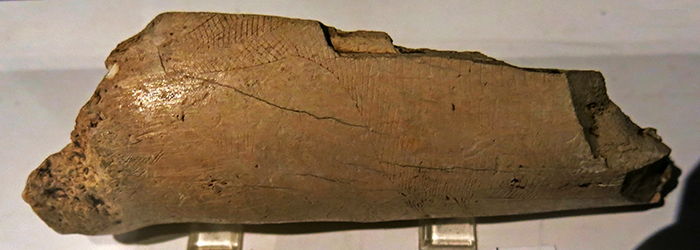
This unique process is used for both the hair, and to express symbolically the volume and the contours of the body.
An identical technique to that used for the head has been used in cross hatching in groups more or less spaced apart on the body was used to express the volume and contours of the body.
Photo: Don Hitchcock 2015
Source: Original, display at Musée d'Aquitaine à Bordeaux
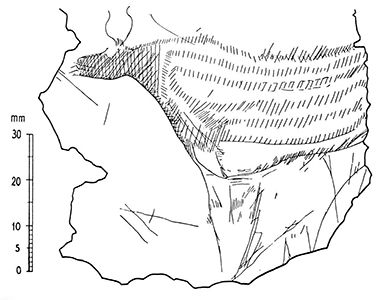
A similar technique with hatching or shading on the head and shading in groups more or less evenly spaced on the body has been used to delineate the outline of a bovid of very similar proportions at La Borie-del-Rey, Blanquefort-sur-Briolance (Lot-et-Garonne), shown here at left.
Although smaller in size, this engraving is nearly identical to the bovid above from l'abri Morin. In both cases, the Upper Magdelanian layer contained azilian points, sometimes with a truncate base. This very special technique, which is not isolated, is dated precisely at these two sites to the very end of the Magdelanian.
Photo and text: Deffarge et al. (1975)

Bone fragment of a long bone of a horse. Length 171 mm, width 34 mm. Used as a compressor for flint knapping, it carries traces of this use on both sides of the engraving, very strong on the left less obvious on the right.
This headless bear from le Morin has not had its stratigraphy recorded. It is in left profile, engraved with clean and vigorous lines. The body is solid. The top of the back is slightly saddle backed, and it has a protruding rump, with the back dropping quickly.
Photo and text: Deffarge et al. (1975)

The small tail is located low and flat against the hindquarters. The abdomen, represented by two lines, is heavy and swollen towards the rear. The two legs shown are unfinished. The hind leg is short and club shaped, the front leg, thrust forward, is significantly longer, very broad, with the appearance of a pole or column.
Text: Deffarge et al. (1975)
Photo: Don Hitchcock 2015
Source: Original, display at Musée d'Aquitaine à Bordeaux
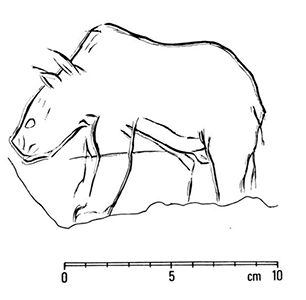
The figure above is very similar with respect to its rump, tail, and forelimb, to a bear from Limeuil, shown at left. It can be added to the relatively short list of bear representations in Quaternary art.
Photo and text: Deffarge et al. (1975)

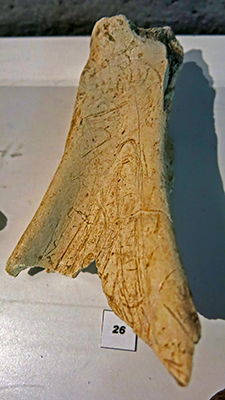
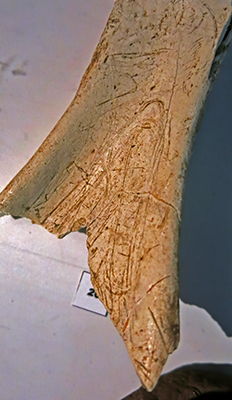
Right scapula of a reindeer. Length 133 mm, width 73 mm. It has not had its stratigraphy recorded.
Above a drawing without obvious meaning, two contours suggest partially superimposed heads, each with an eye, a globular head, and perhaps a snout. They evoke masked figures.
Photo (left) and text: Deffarge et al. (1975)
Photo (centre and right): Don Hitchcock 2015
Source: Original, display at Musée d'Aquitaine à Bordeaux
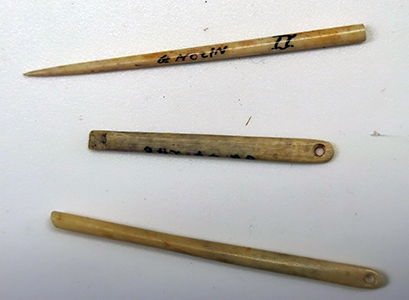
Needles from le Morin.
Catalog: 88.47.246, 88.47.248, 88.47.1599
Photo: Don Hitchcock 2015
Source: Original, display at Musée d'Aquitaine à Bordeaux
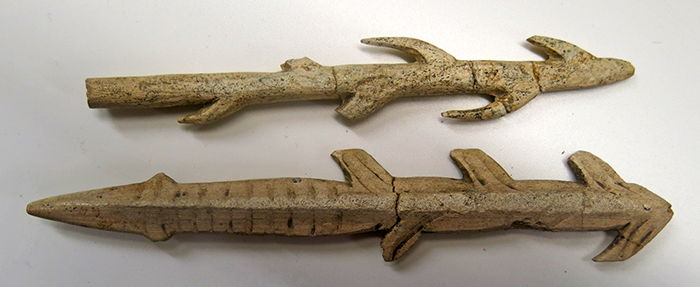
Harpoons from le Morin.
These harpoons have two rows of barbs, and are made of reindeer antler.
Catalog: 88.47.1123, 88.47.1678
Photo: Don Hitchcock 2015
Source: Original, display at Musée d'Aquitaine à Bordeaux
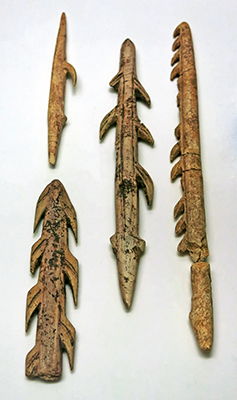
Harpoons with one or two rows of barbs, from Laugerie Haute, Laussel and from Le Morin.
Upper Magdalenian, in reindeer antler.
Top left: Harpoon with one row of barbs, Magdalenian V-VI, length 12 cm, Laugerie Haute, Catalog 61.3.54.
Right: Harpoon with one row of barbs, Magdalenian V, length 225 mm, Laussel, Catalog 61.3.55.
Photo: Don Hitchcock 2015
Catalog: 61.3.54, 61.3.55, 88.47.389, 88.47.395.
Source and text: Original, Musée d'Aquitaine à Bordeaux
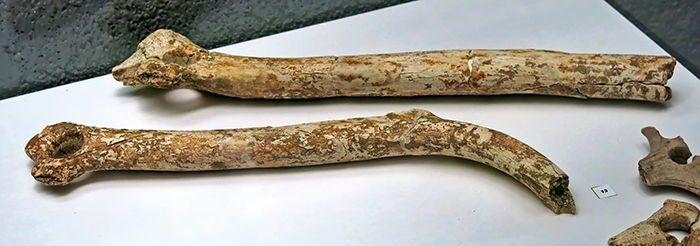
These pierced batons are probably from le Morin, by a process of elimination of known pierced batons in the display, the others being from Cap Blanc and la Madeleine, shown partially at bottom right, and detailed with full photos on those pages.
Photo: Don Hitchcock 2015
Catalog: 88.47.120, 88.47.121 (?)
Source: Original, Musée d'Aquitaine à Bordeaux
References
- Deffarge R., Laurent P., de Sonneville-Bordes D., 1974: Ciseaux ou lissoirs magdaleniens, Bulletin de la Société Préhistorique Française. Comptes rendus des séances mensuelles , Year 1974 Volume 71 Issue 3 pp. 85-96
- Deffarge R., Laurent P., de Sonneville-Bordes D., 1975: Art mobilier du Magdalénien supérieur de l'Abri Morin à Pessac-sur-Dordogne (Gironde), Gallia préhistoire, Tome 18 fascicule 1, 1975. pp. 1-64.
- Géroudet P., 1965: Les Rapaces diurnes et nocturnes d'Europe, Université Lumière-Lyon 2, Delachaux & Niestlé, 6ème édition (1984), Paris, 426 p.
- Gourichon L., 1994: Les Harfangs (Nyctea scandiaca L. du gisement madgalénien du Morin (Gironde), Université Lumière-Lyon 2, Master's Thesis, 1994
- Maligne M., Langlais J., Barshay-Szmidt C., 2012: Des restes de chiens magdaléniens à l’abri du Morin (Gironde, France). Implications socio-économiques d’une innovation zootechnique, PALEO, 23 / 2012, pp. 39-54.
- Pruitt W., Pepper H., 1986: 'Pepper's patches' on Rangifer pelage, Rangifer, Special Issue No. 1, 1986
- Saachi D., 1972: Une Curieuse gravure d'oiseau dans le gisement magdalenien de Belvis (Aude), Zephyrus, 7S-4: 189-192.
- Vrba E., Schaller G., 2000: Antelopes, Deer, and Relatives: Fossil Record, Behavioral Ecology, Systematics, and Conservation, Yale University Press


